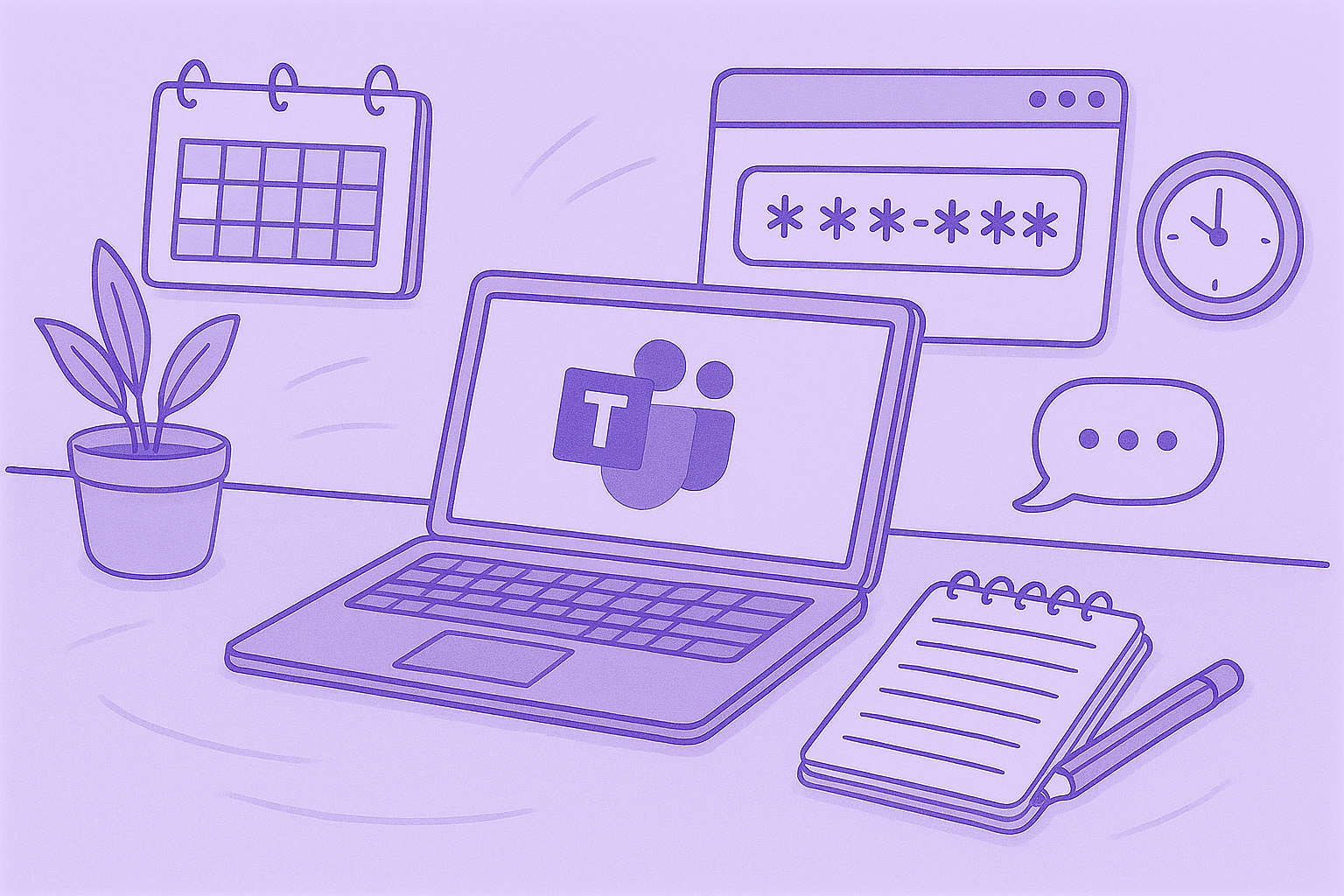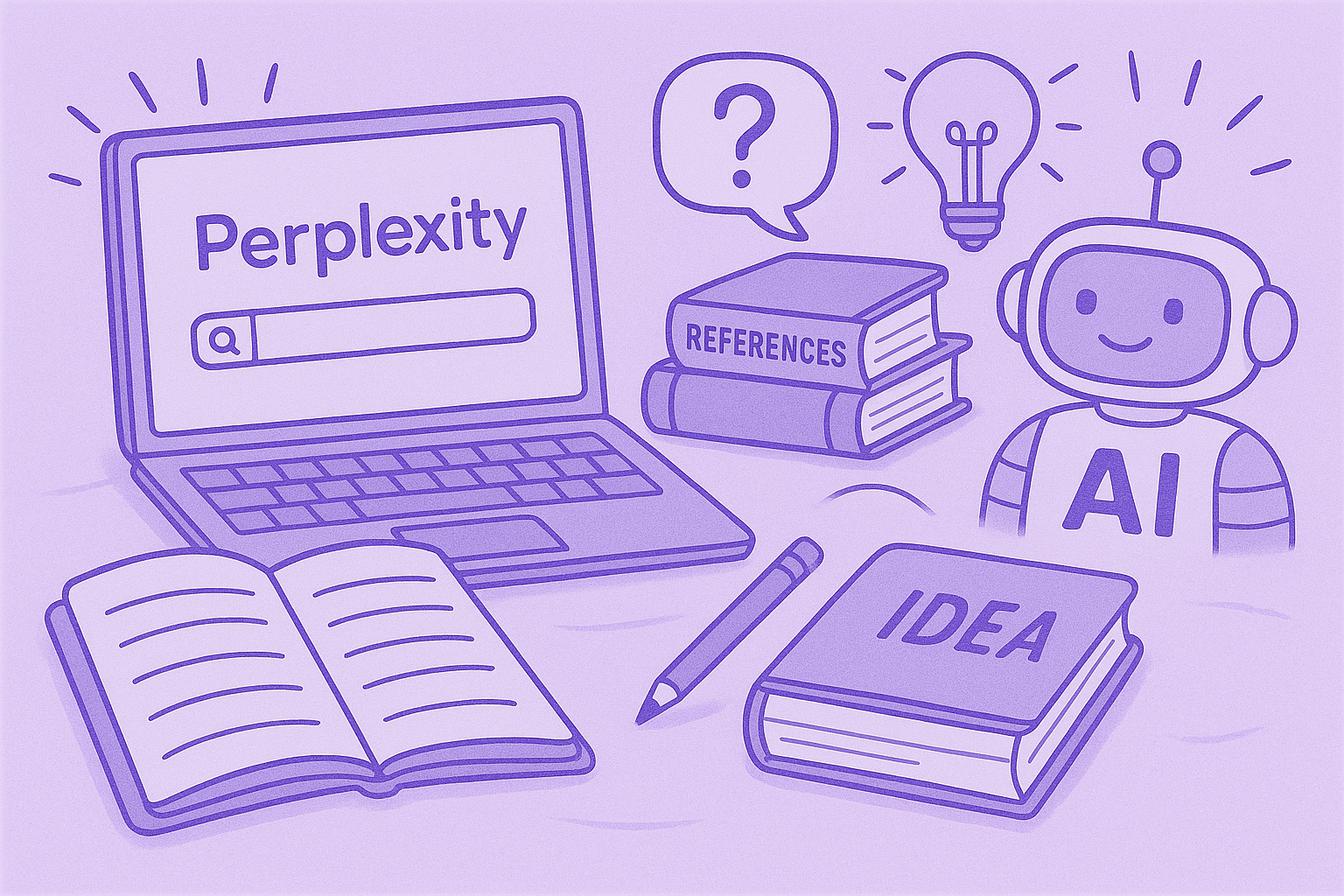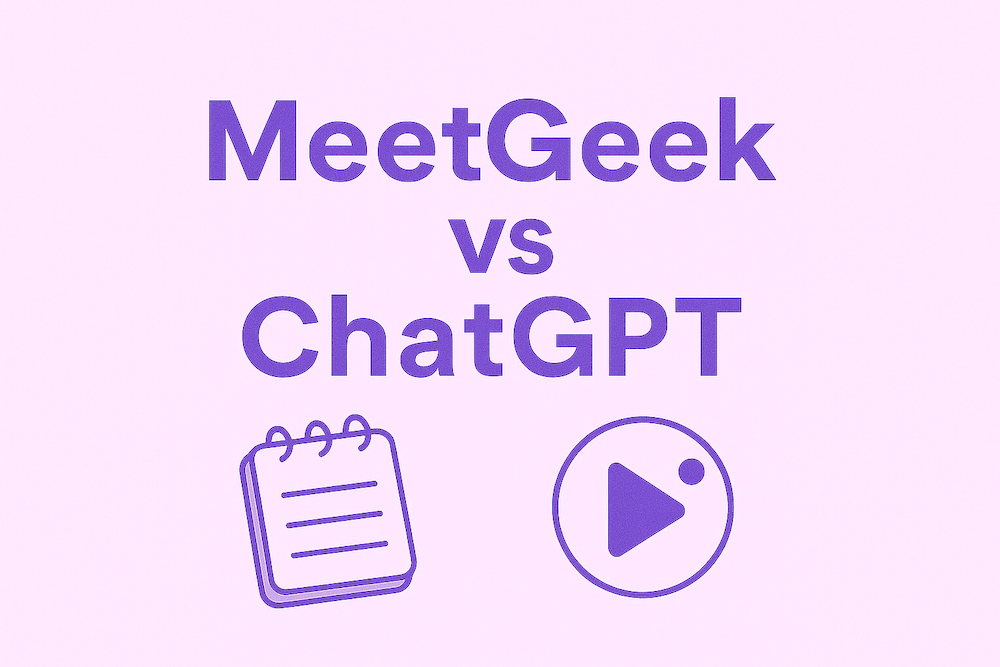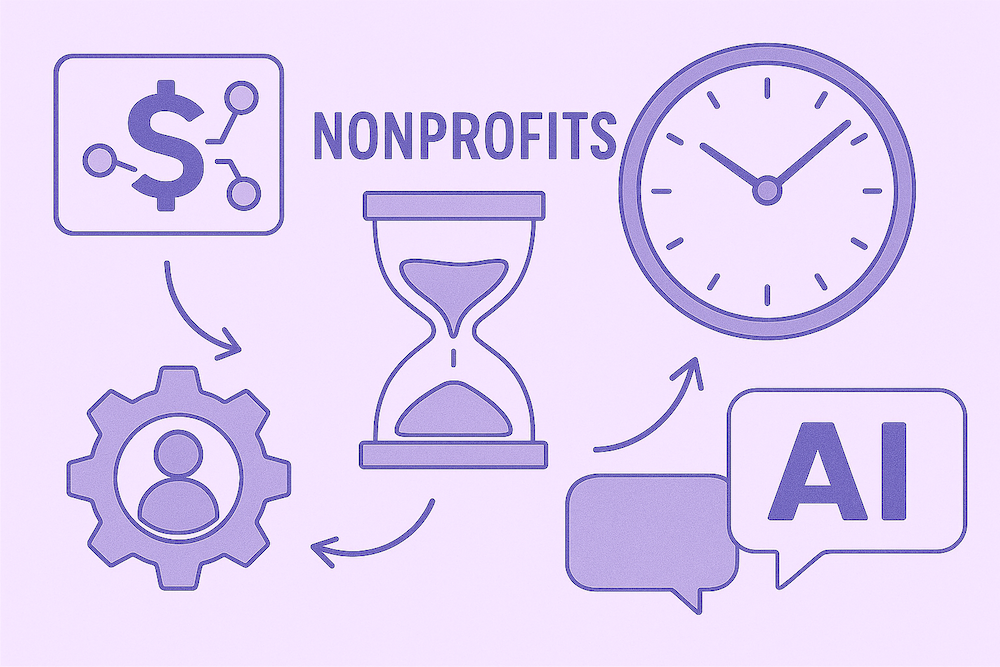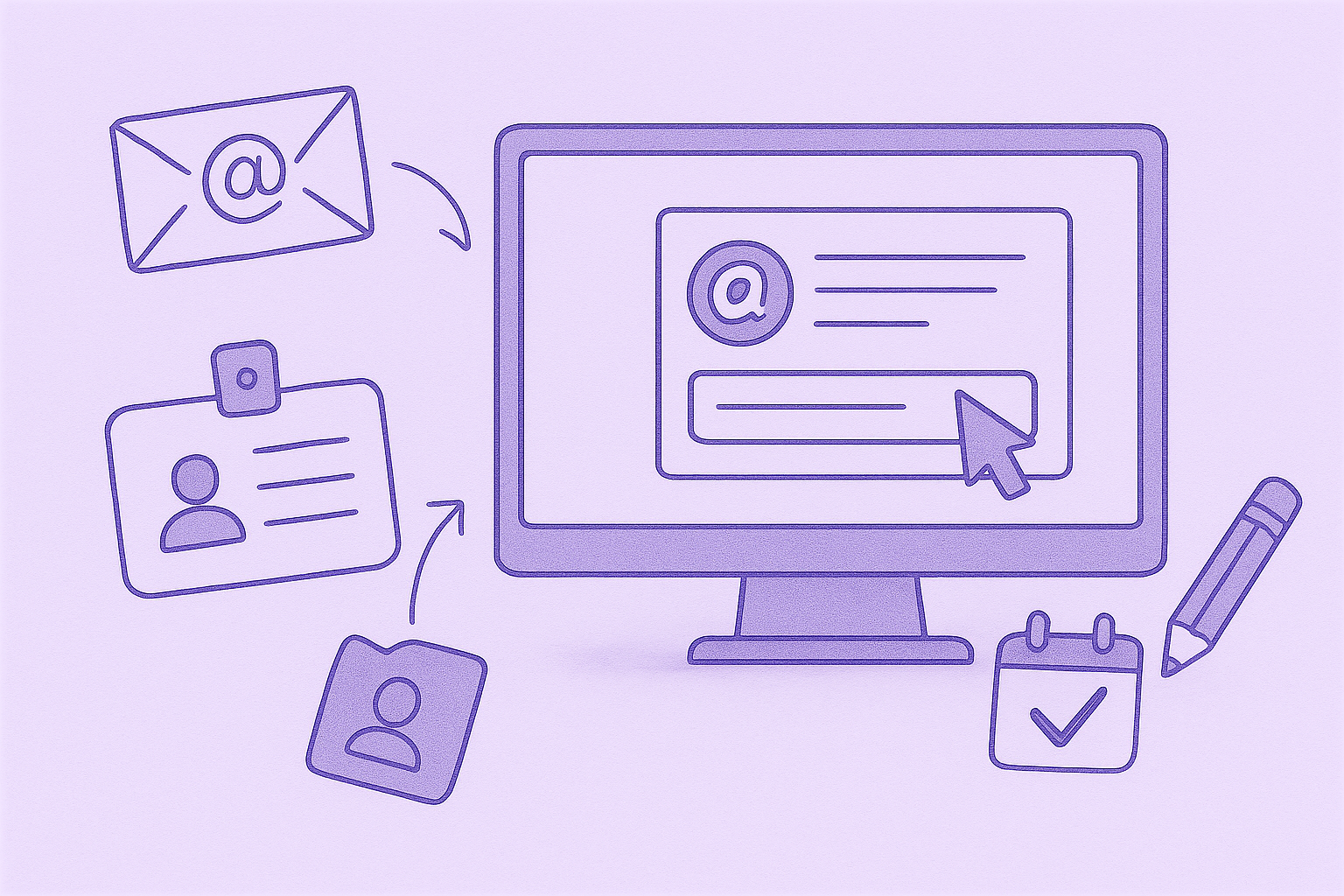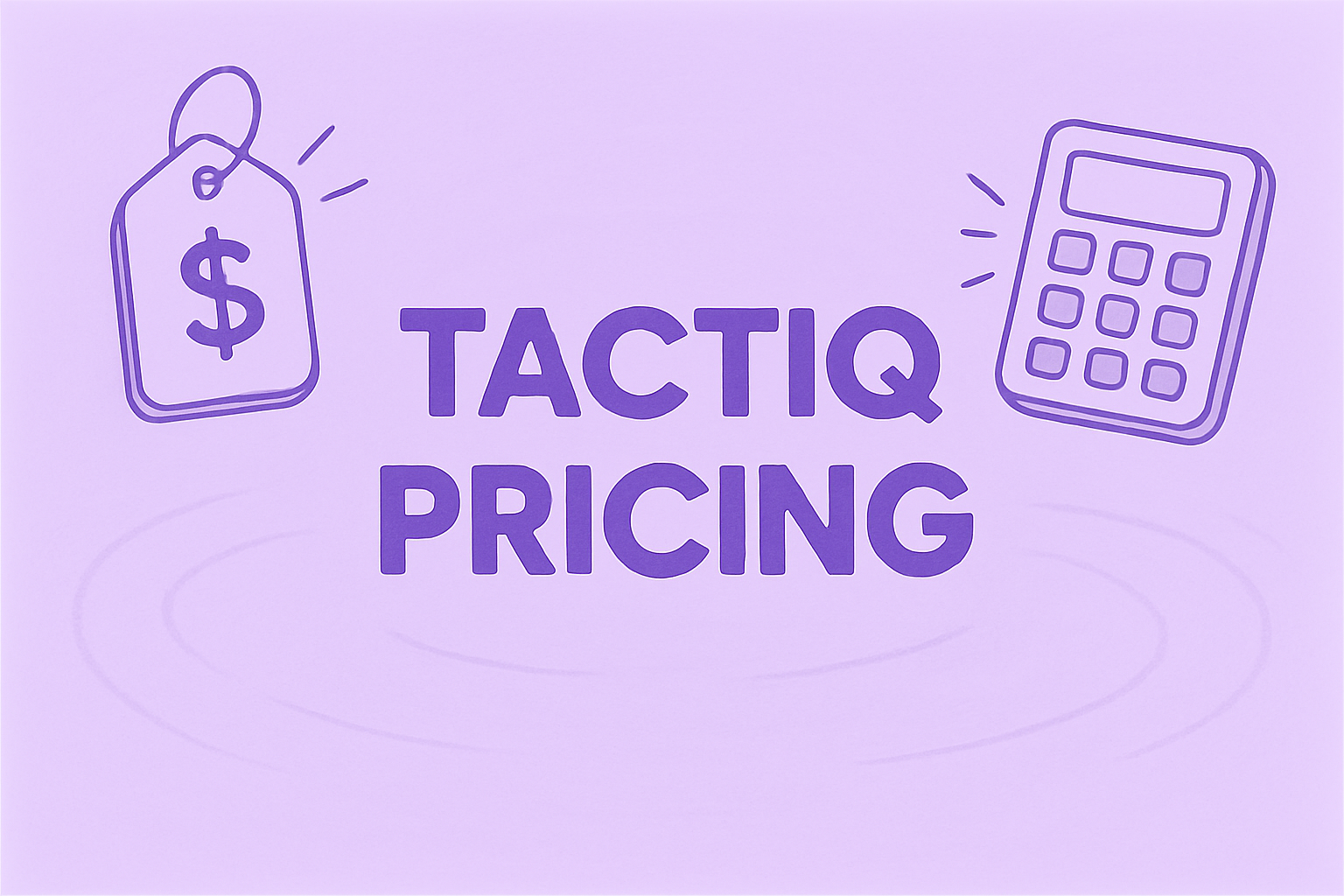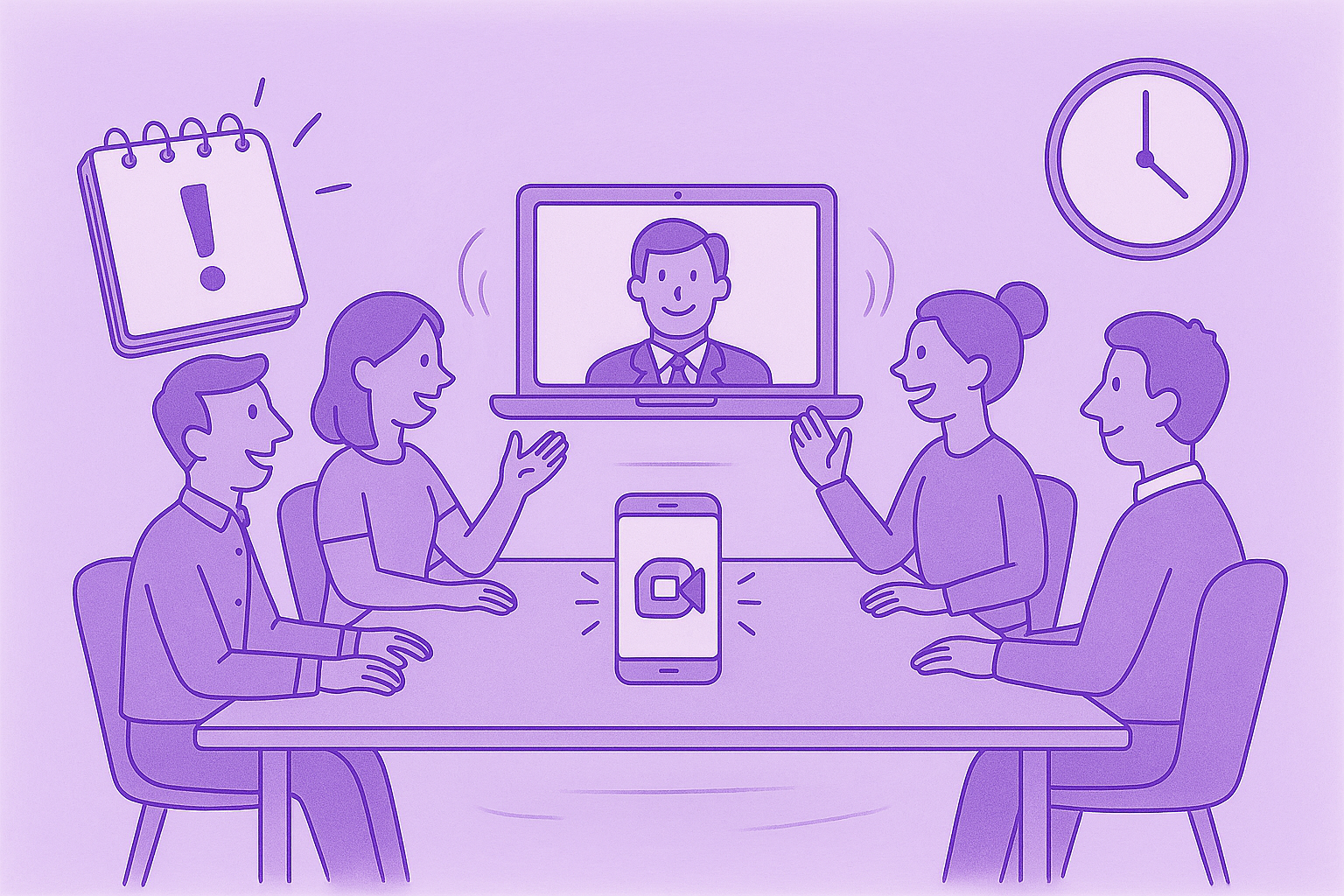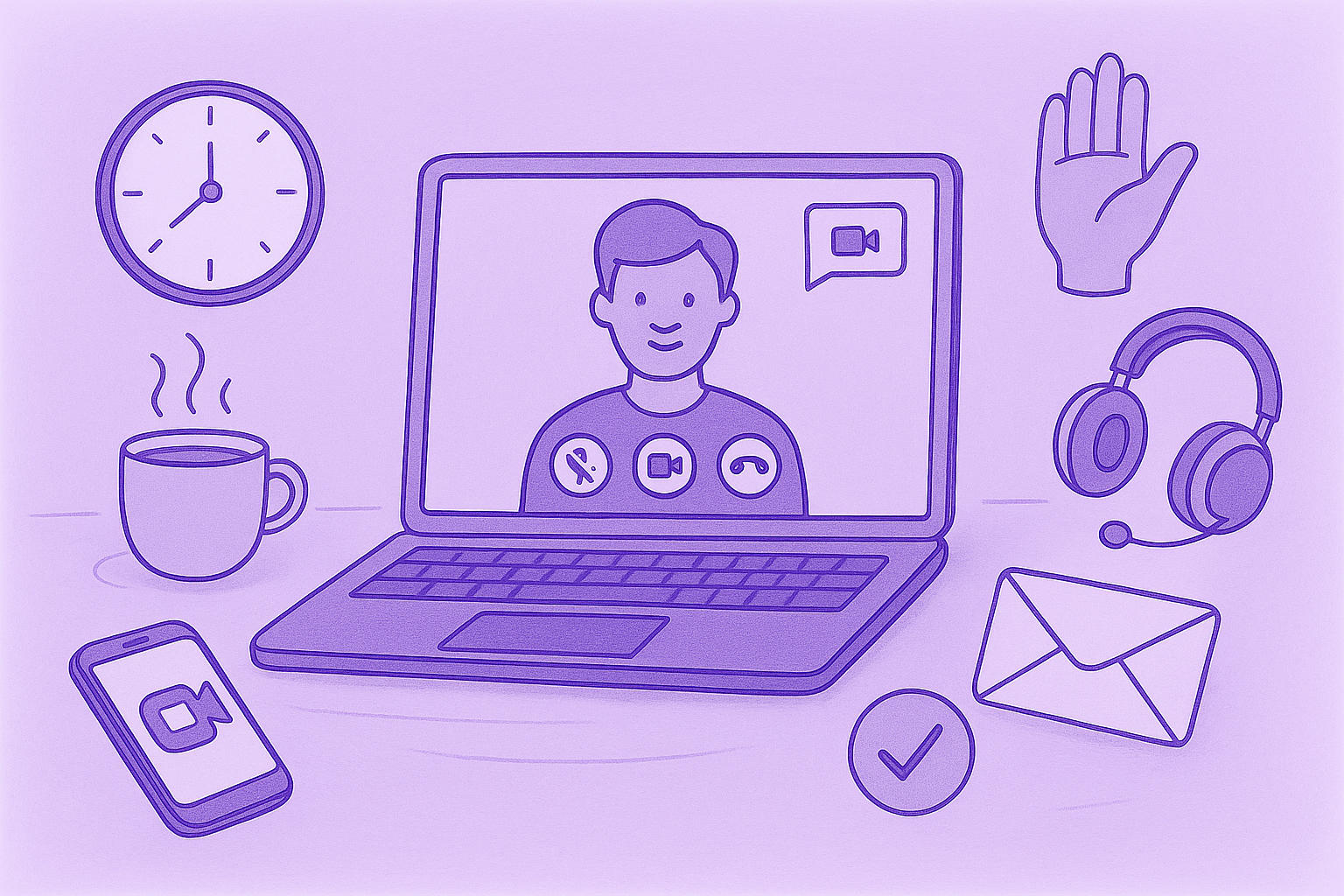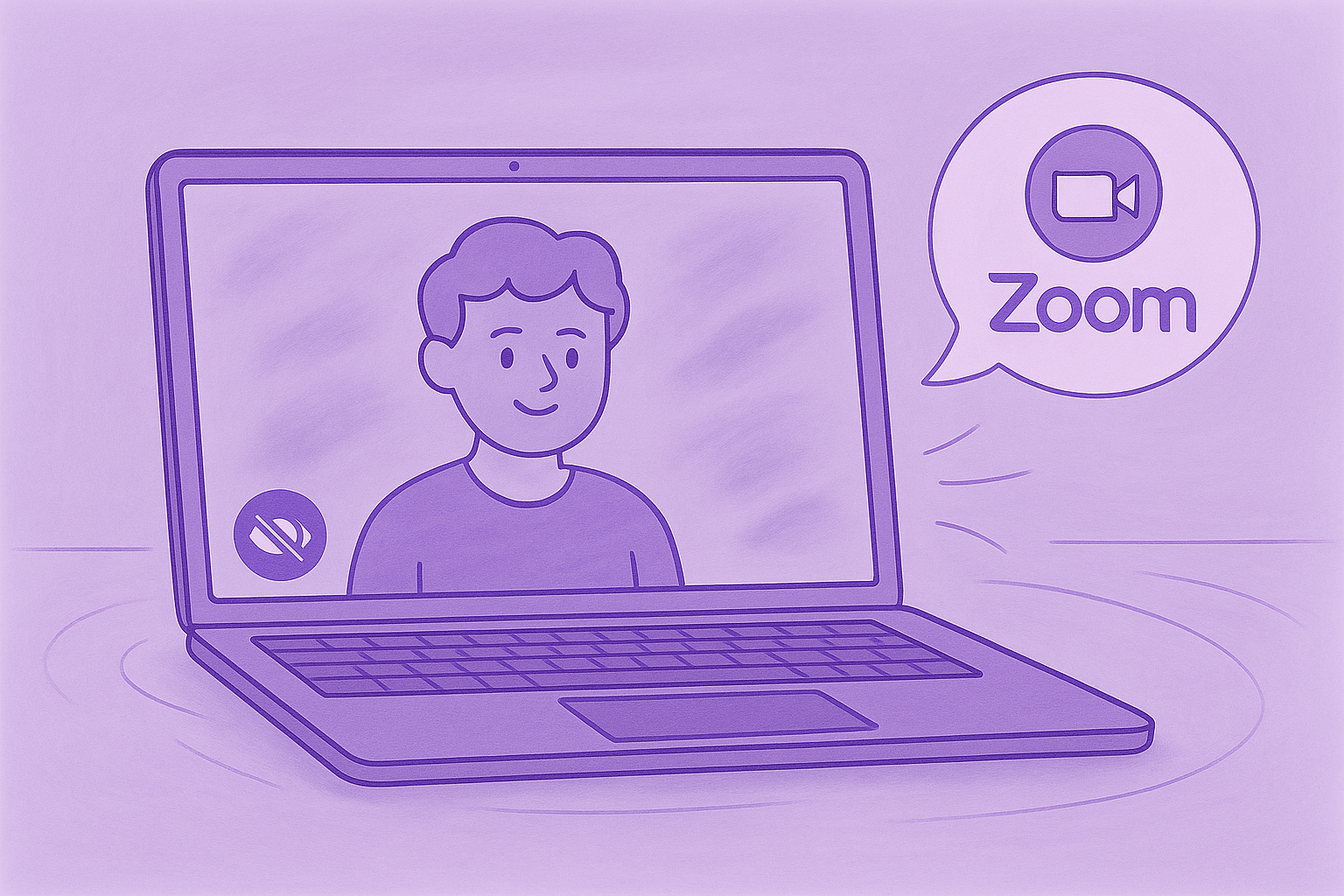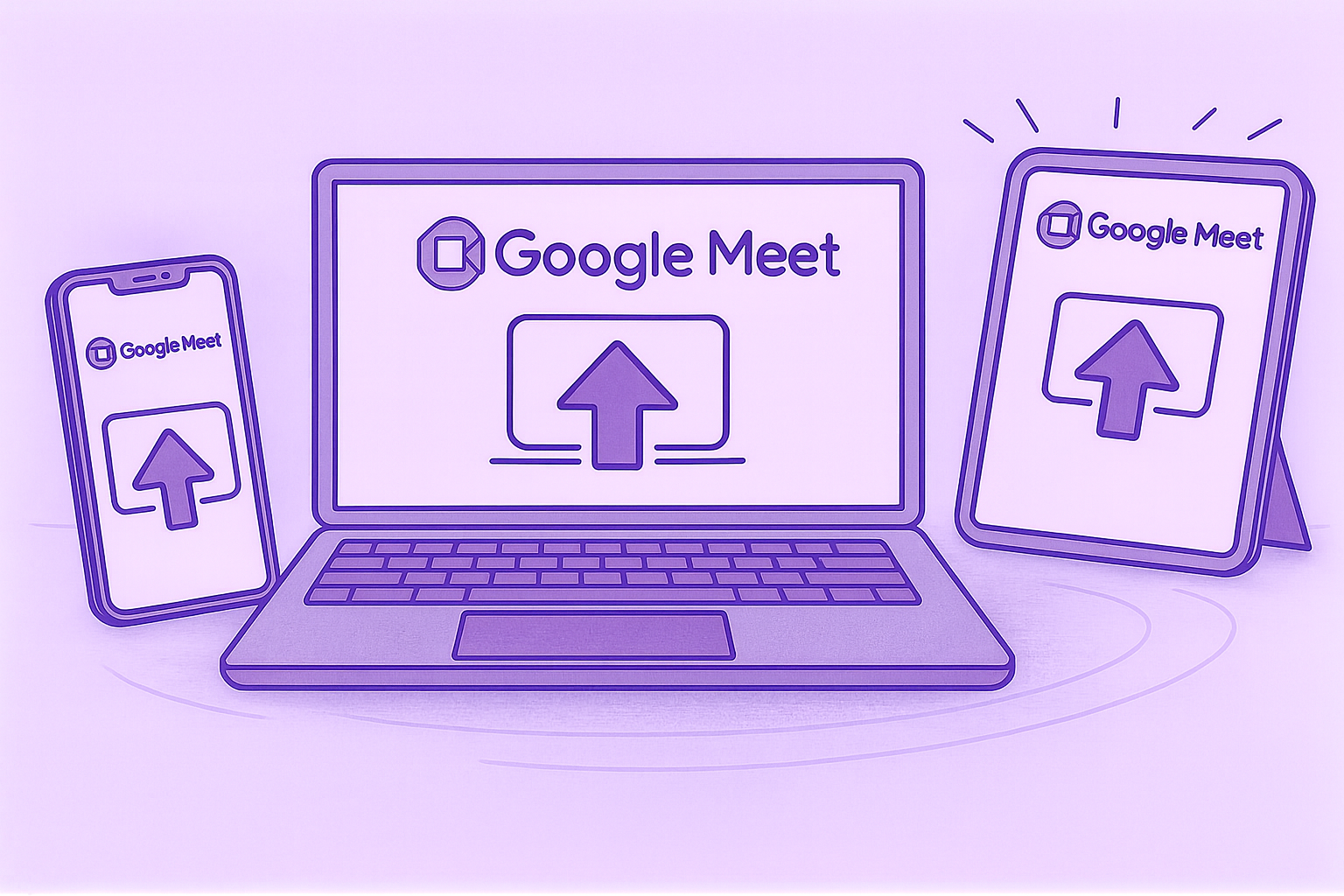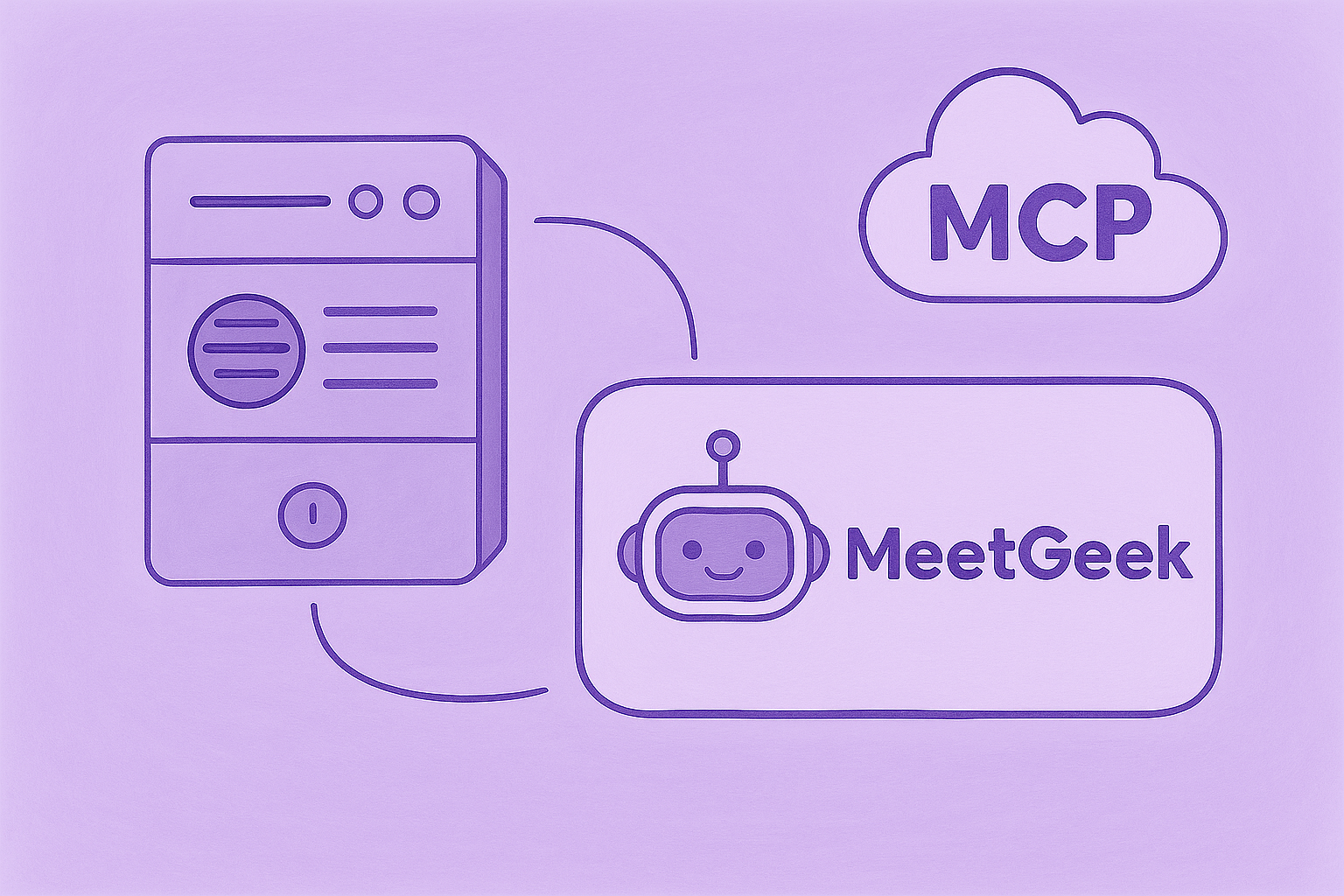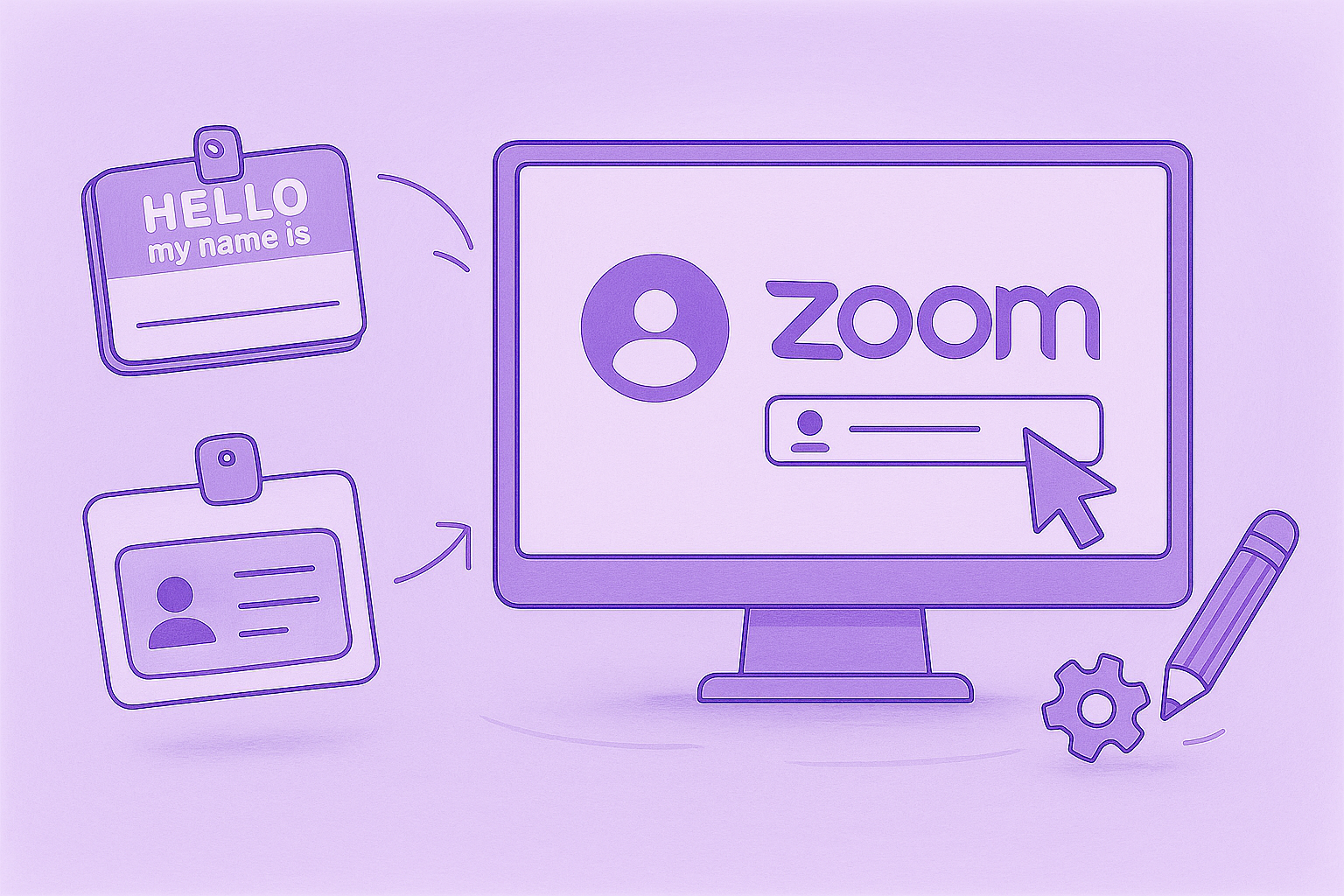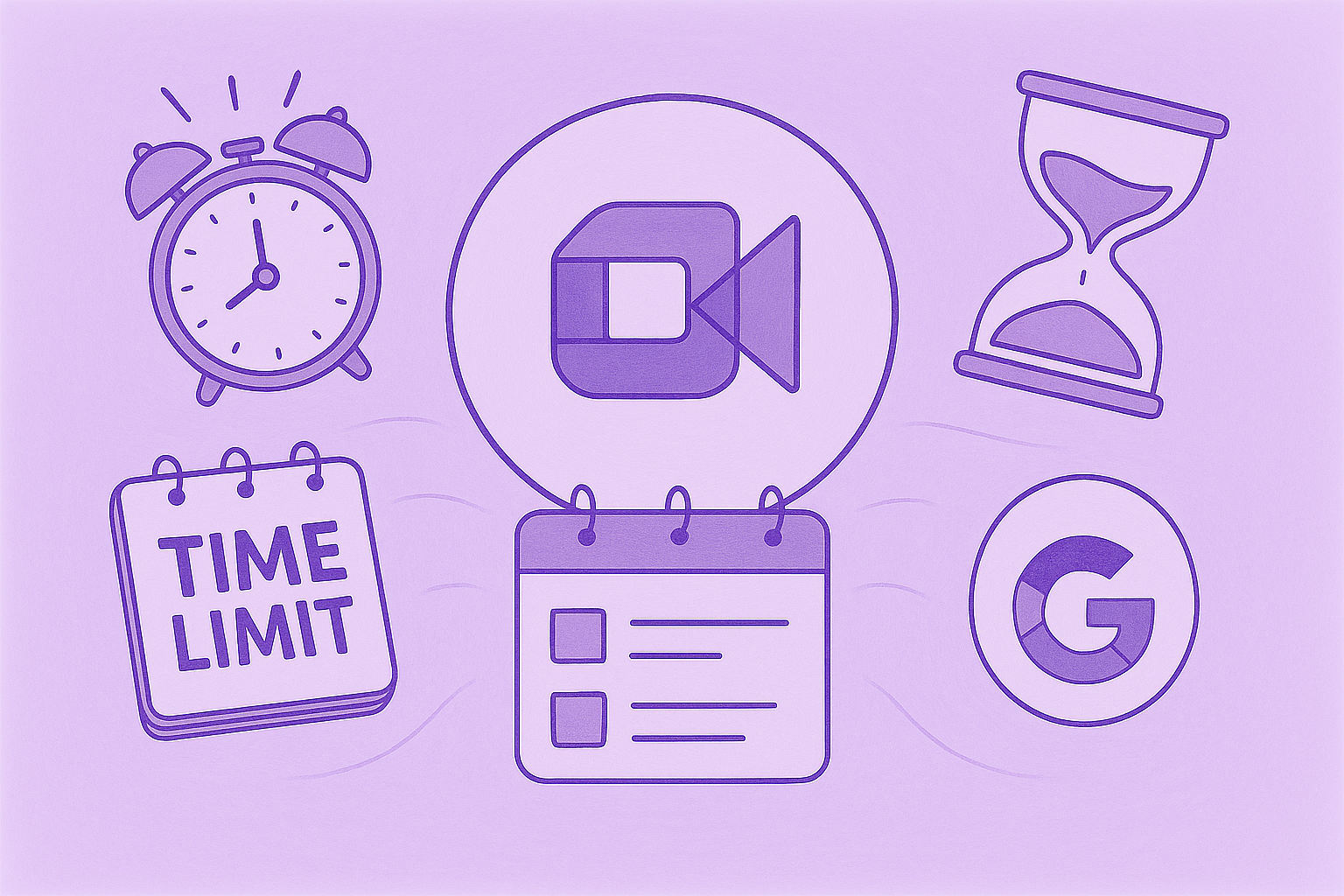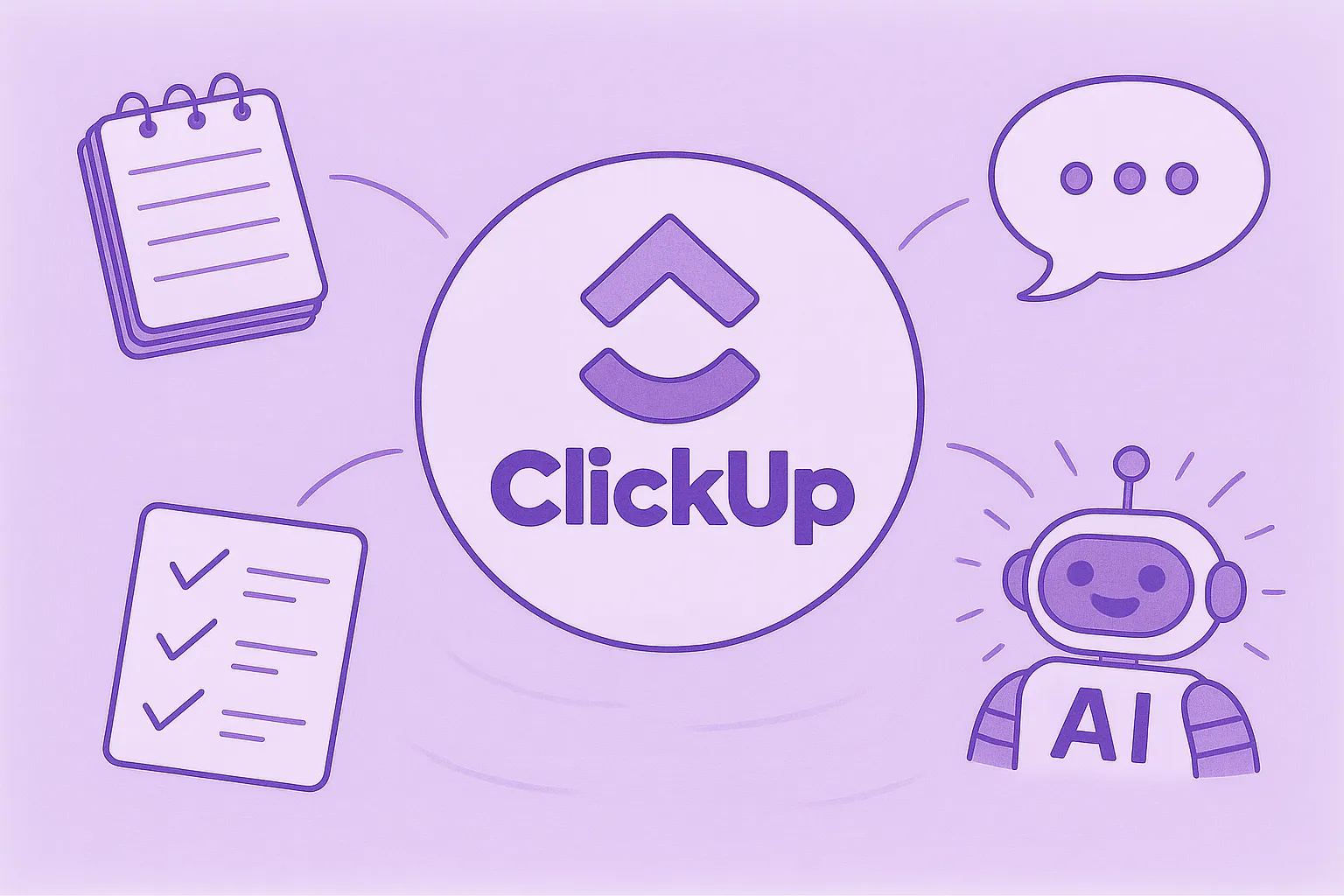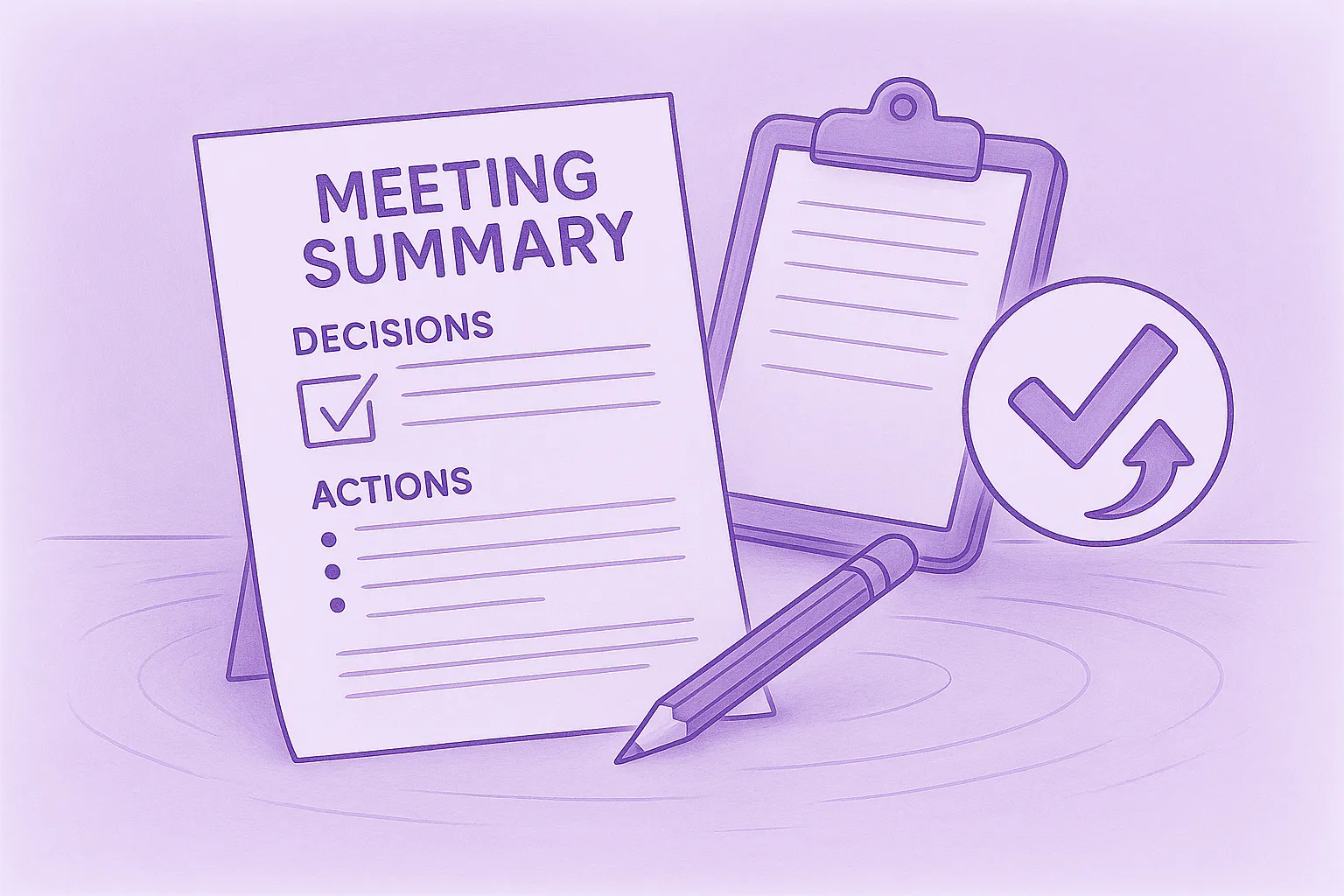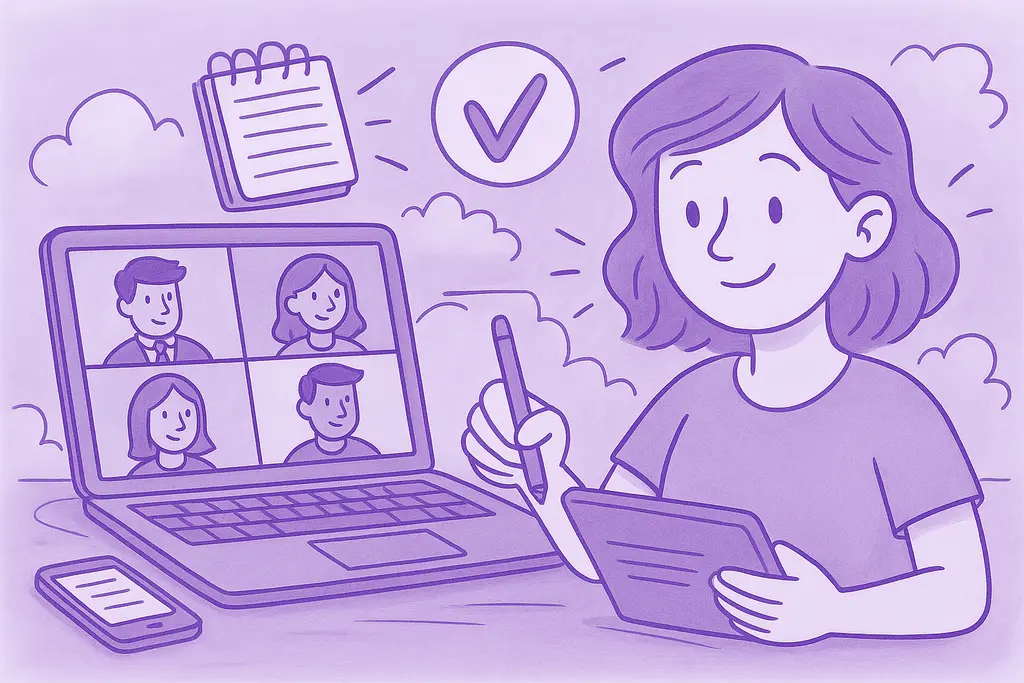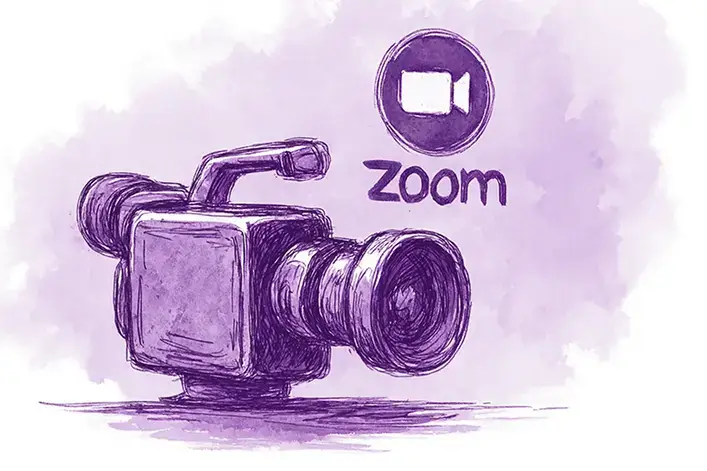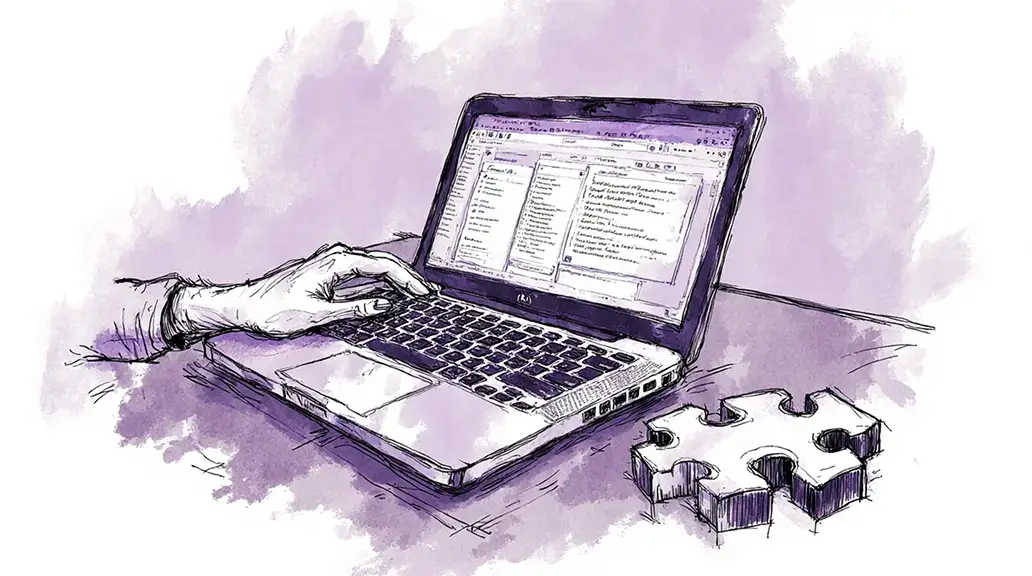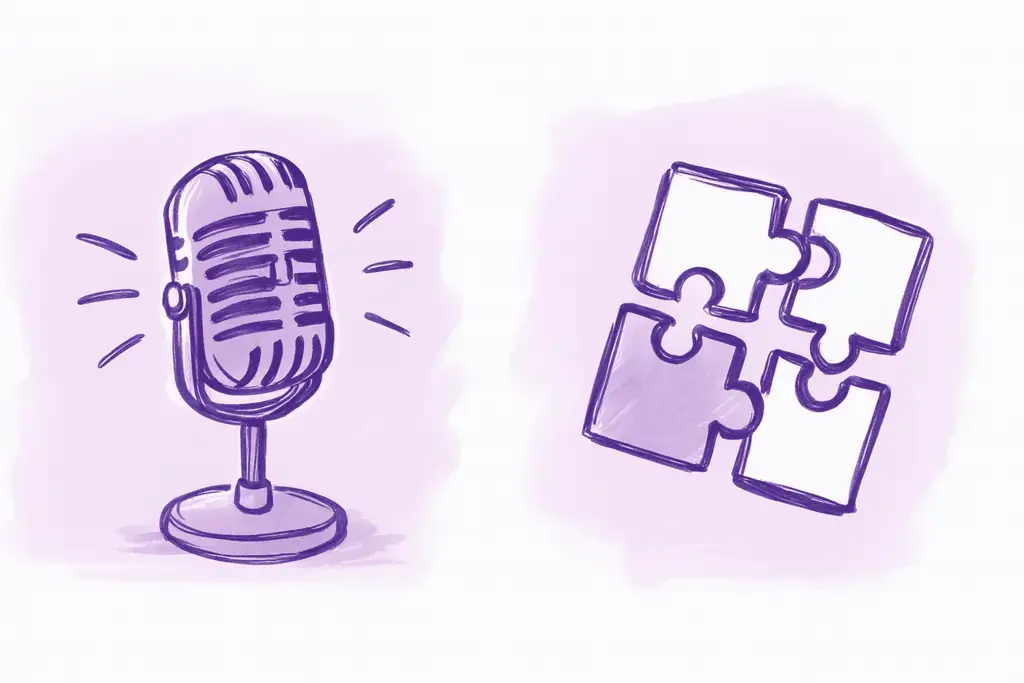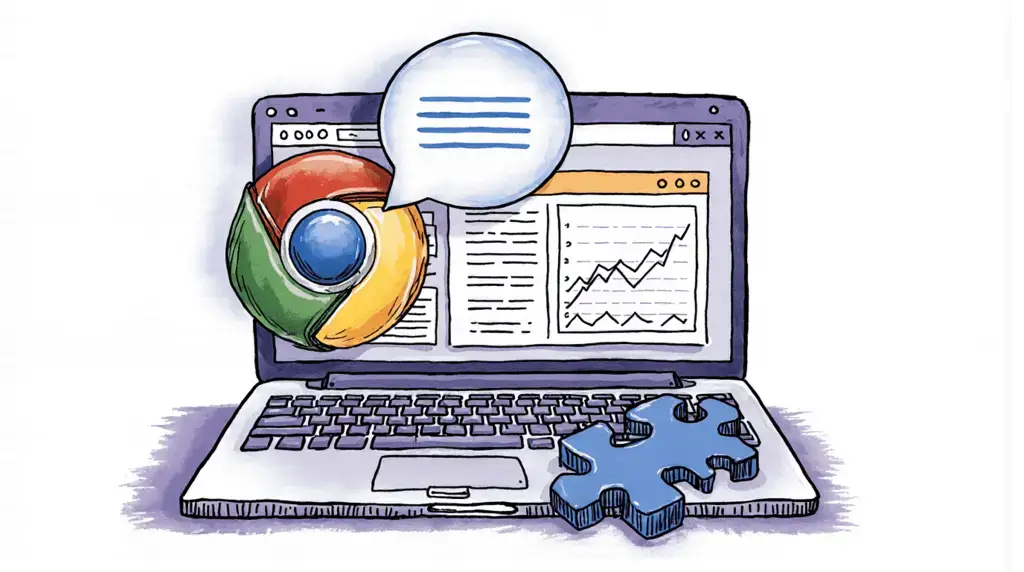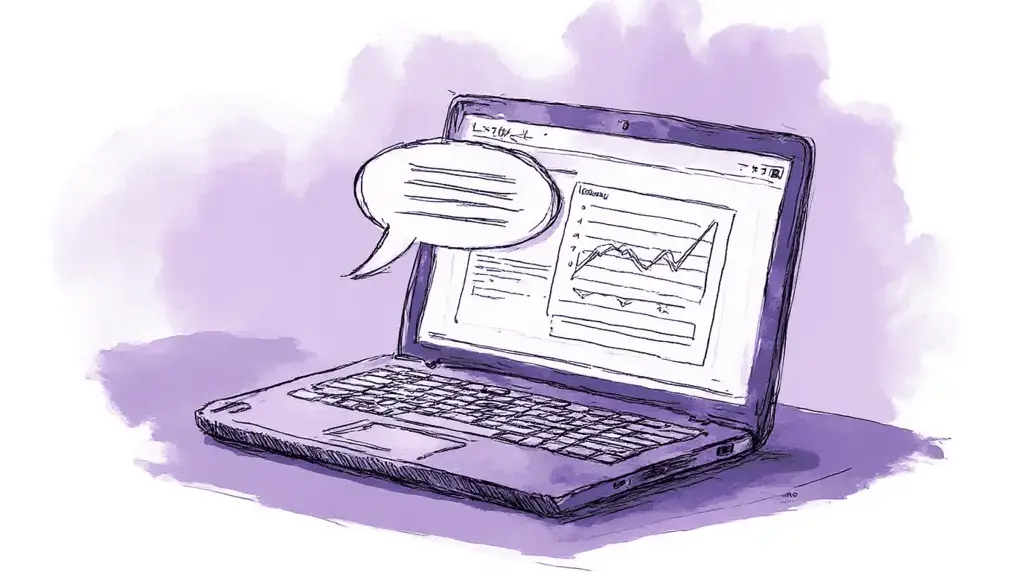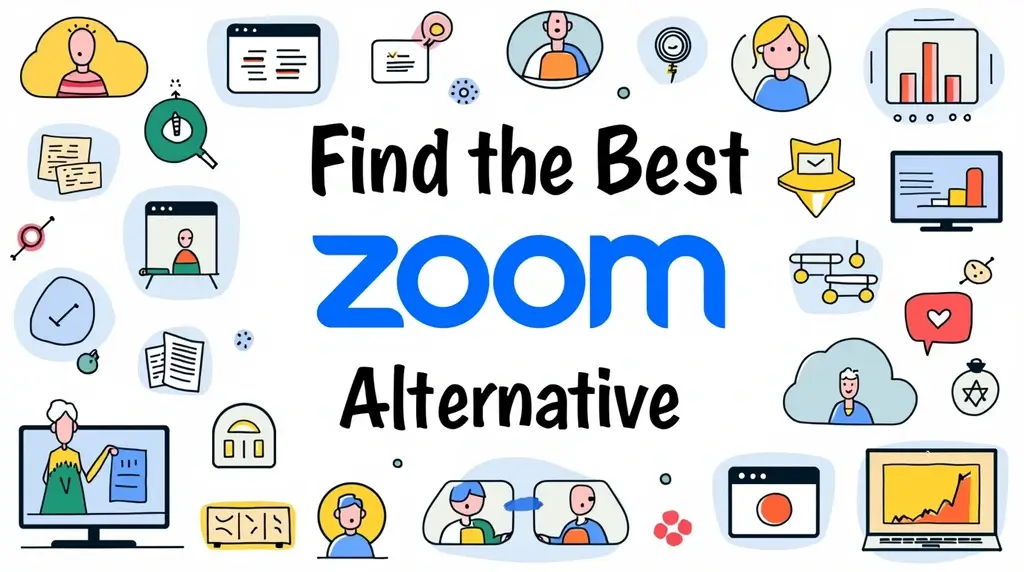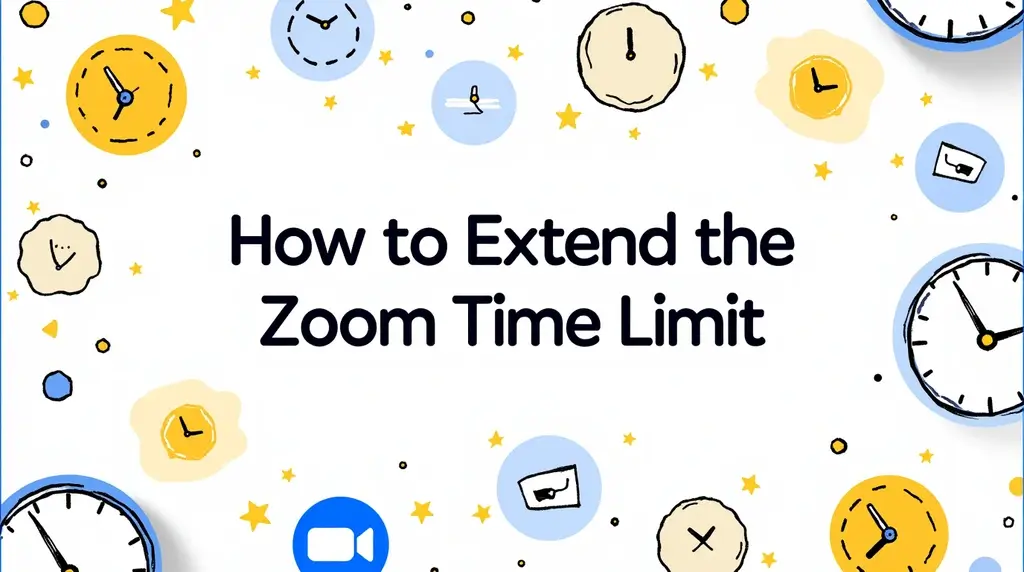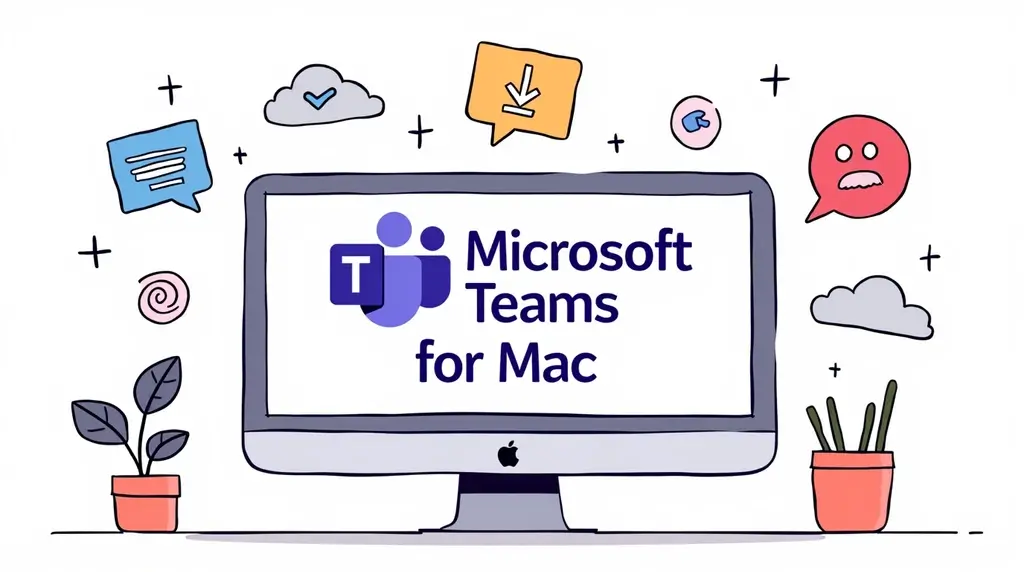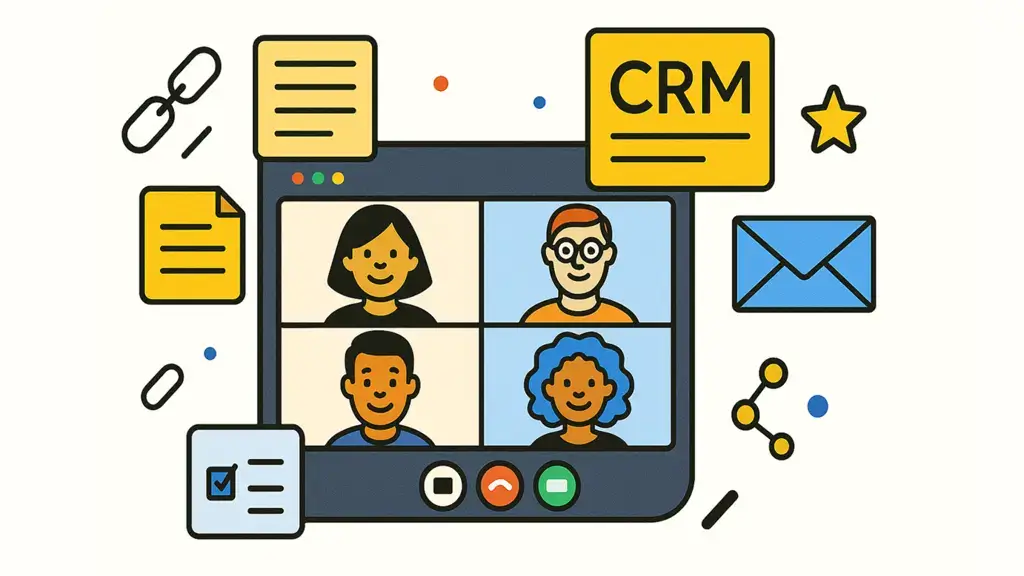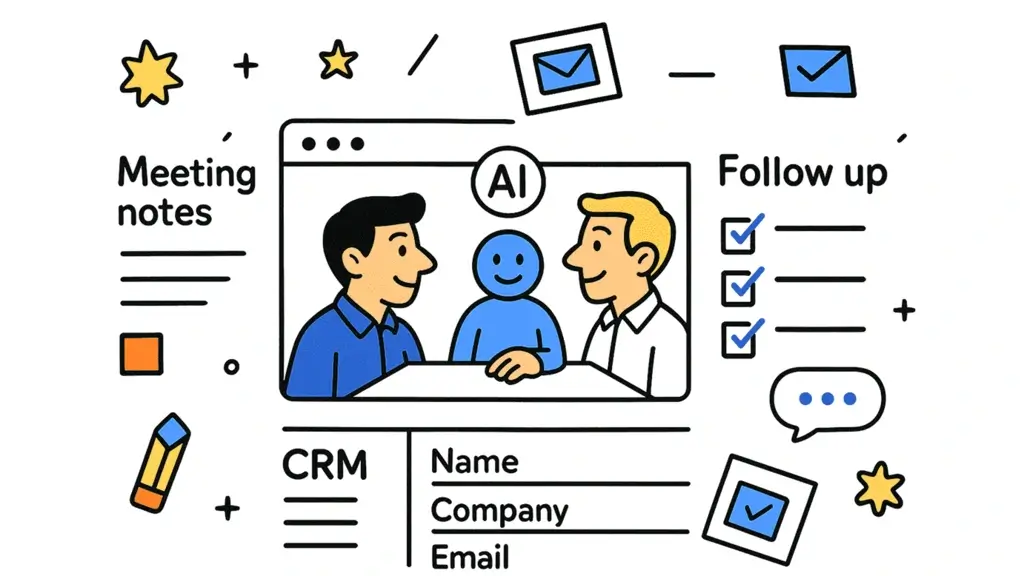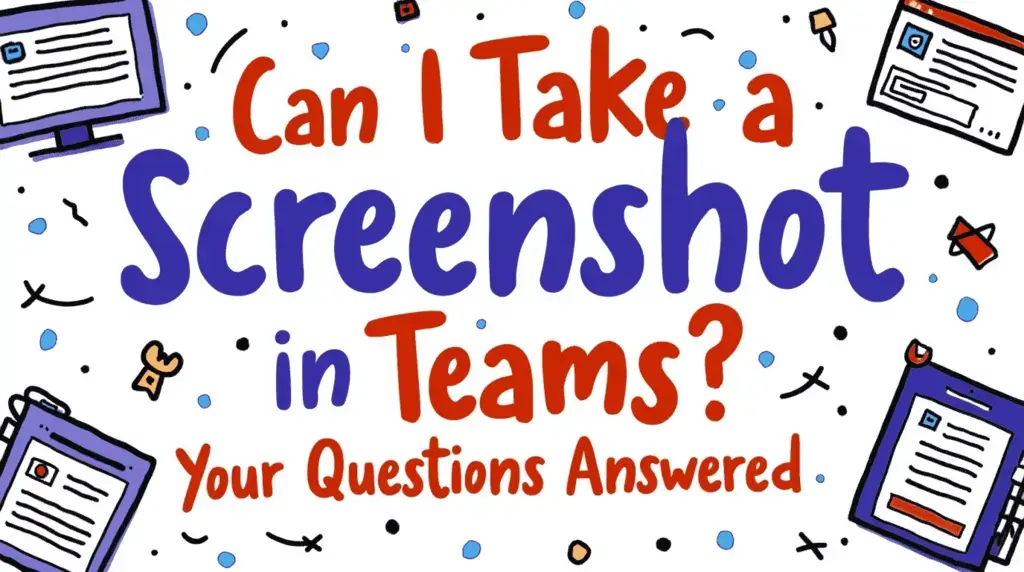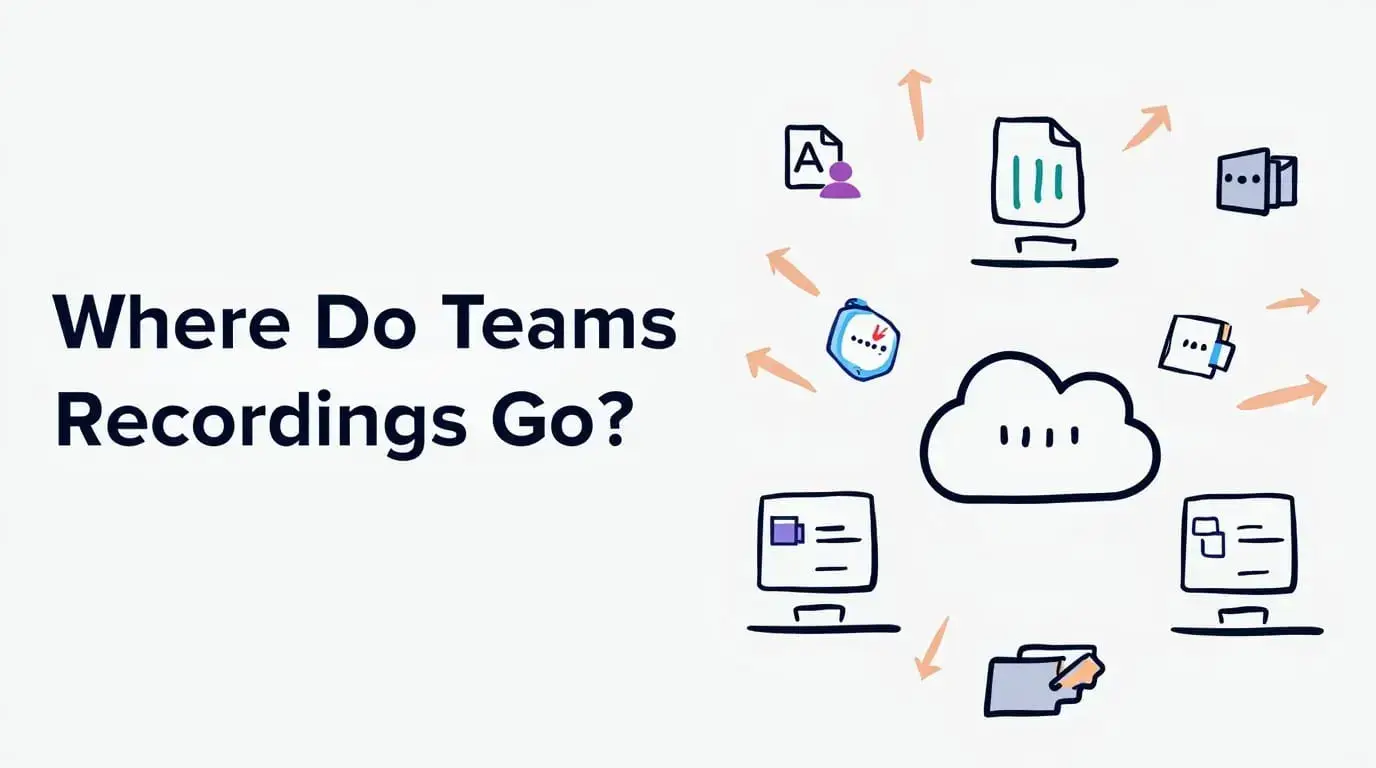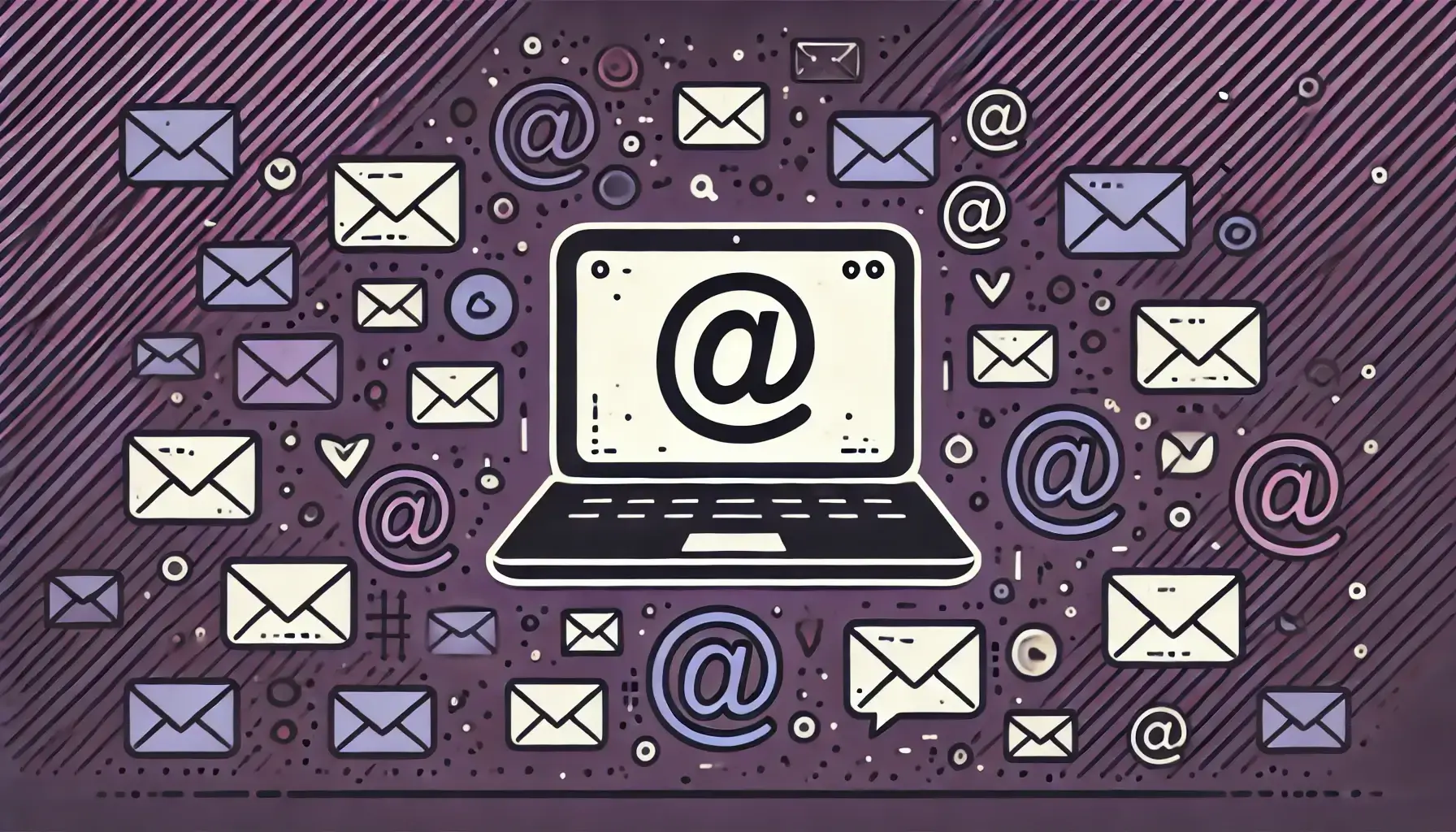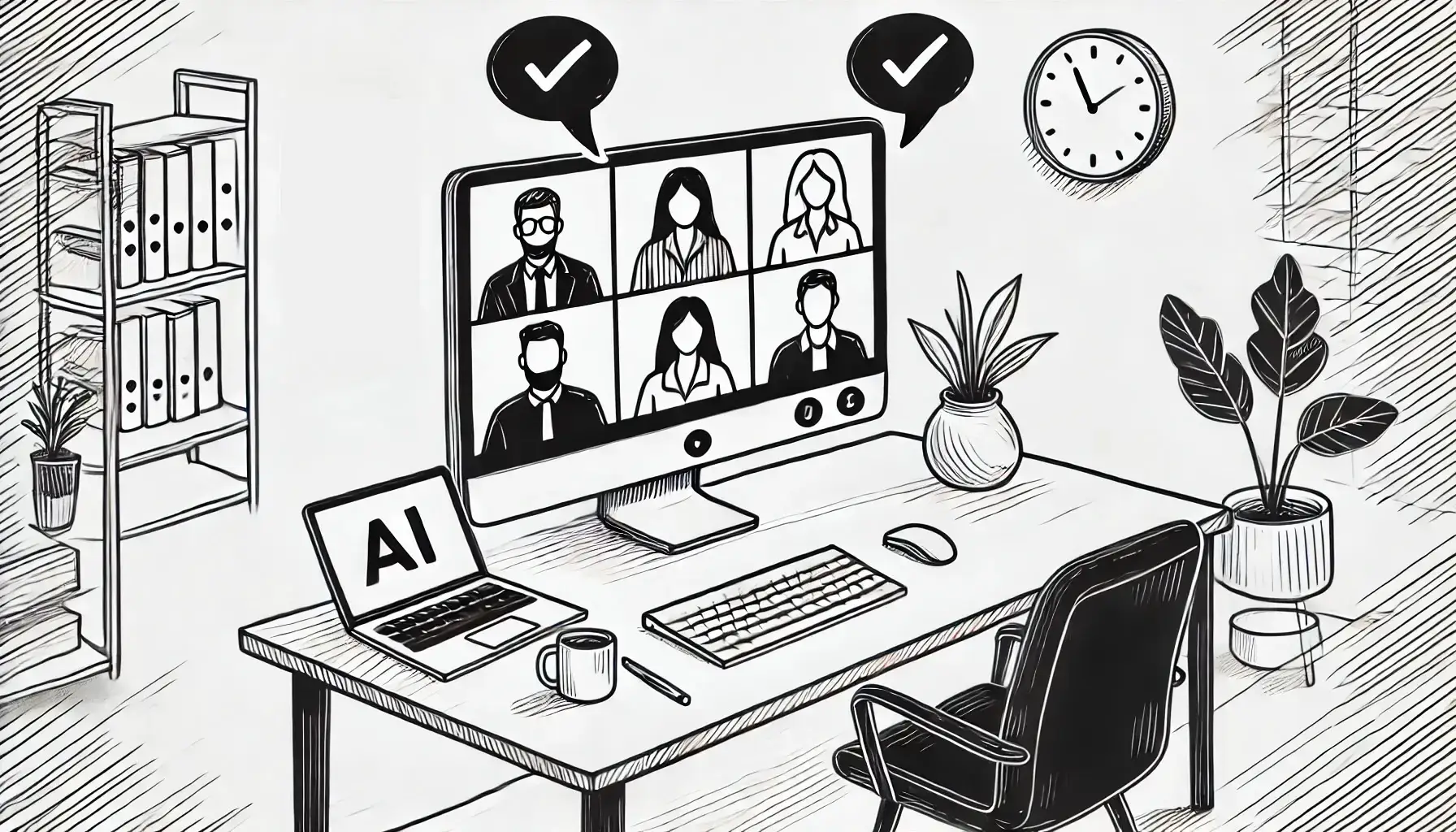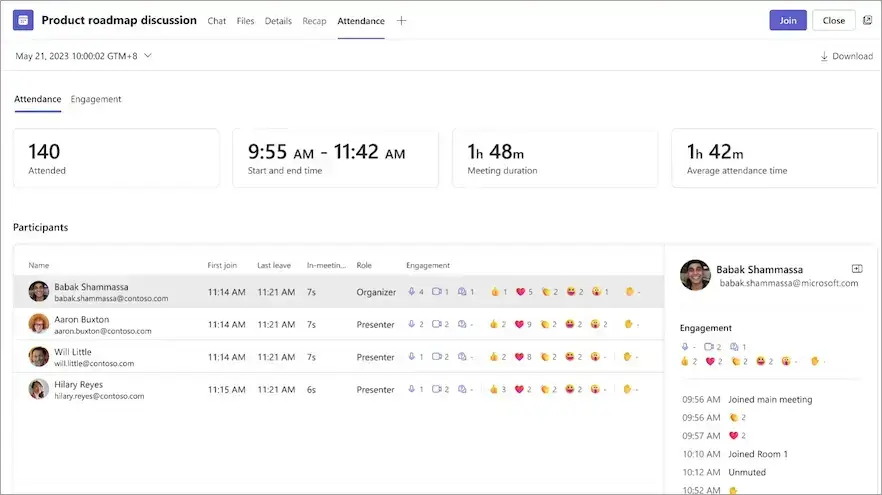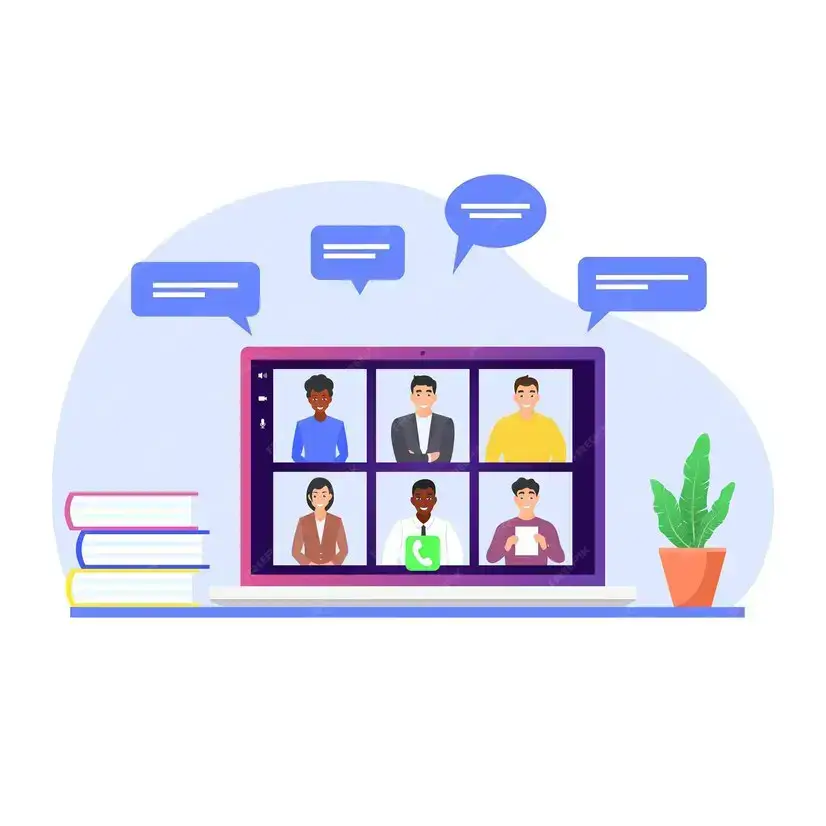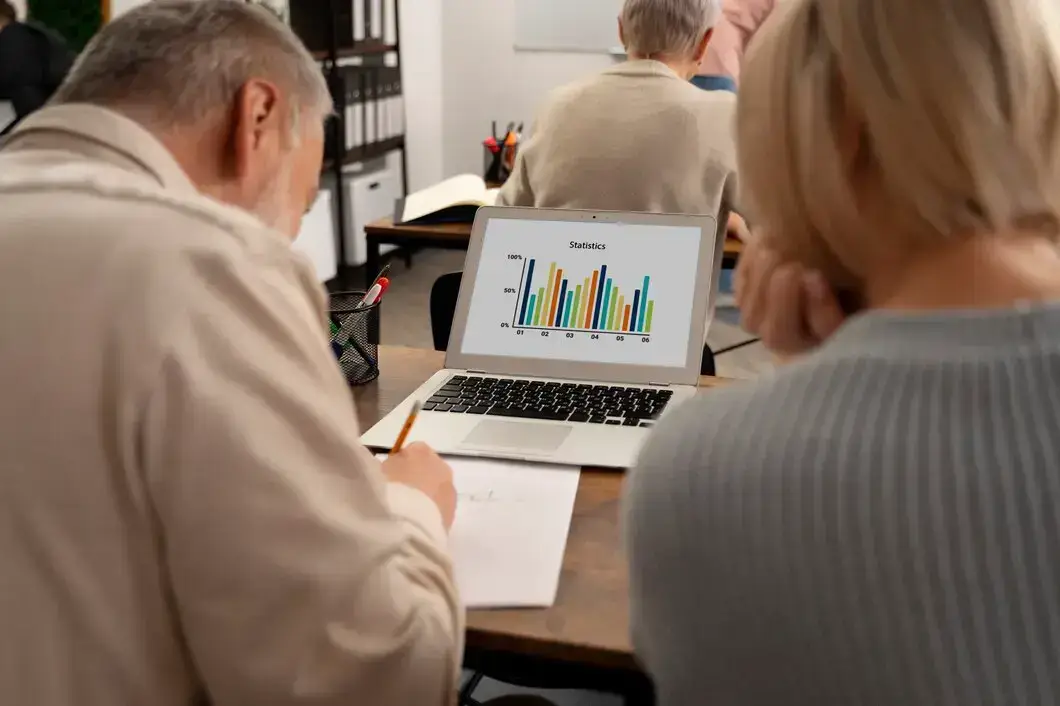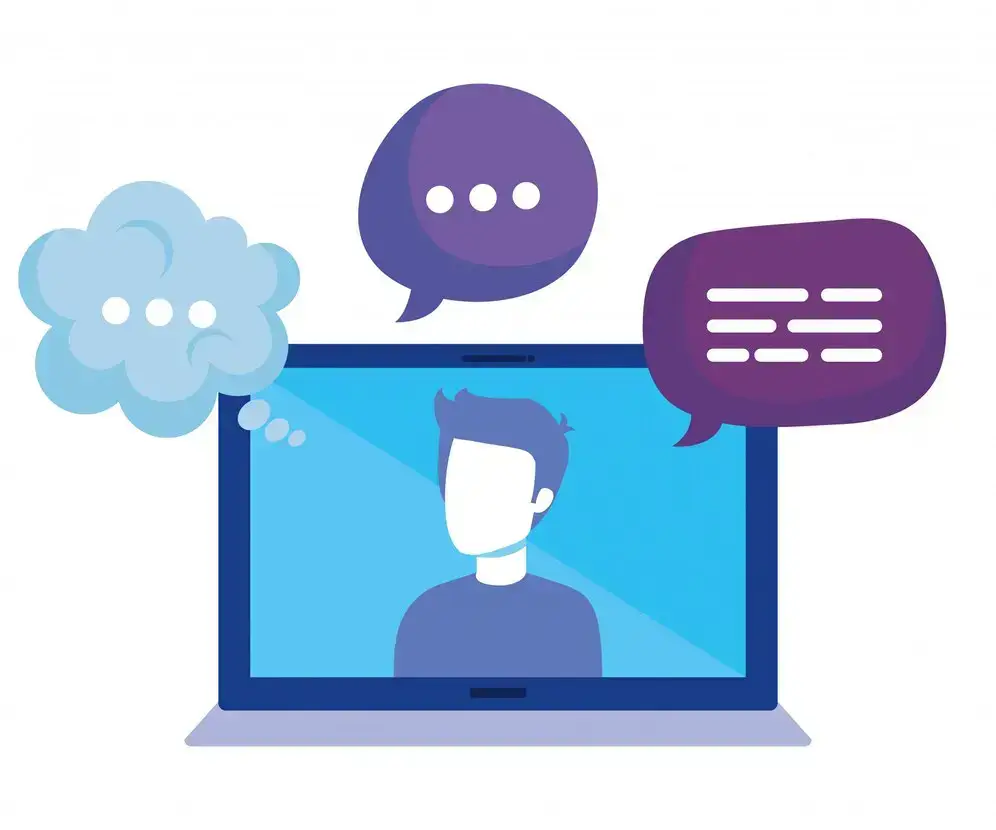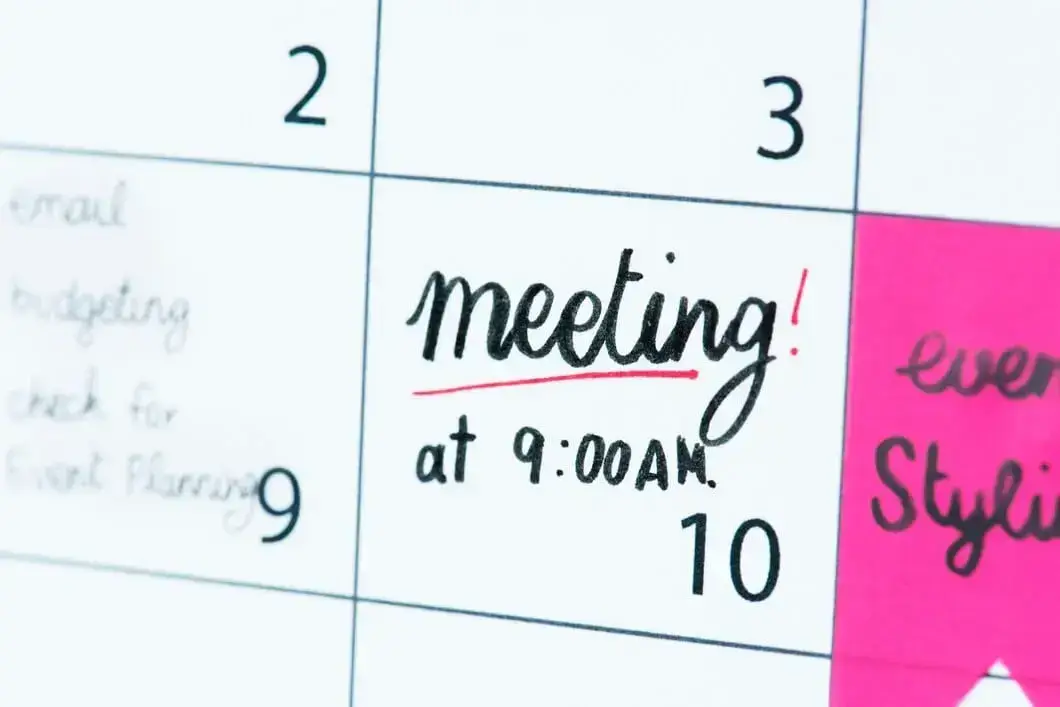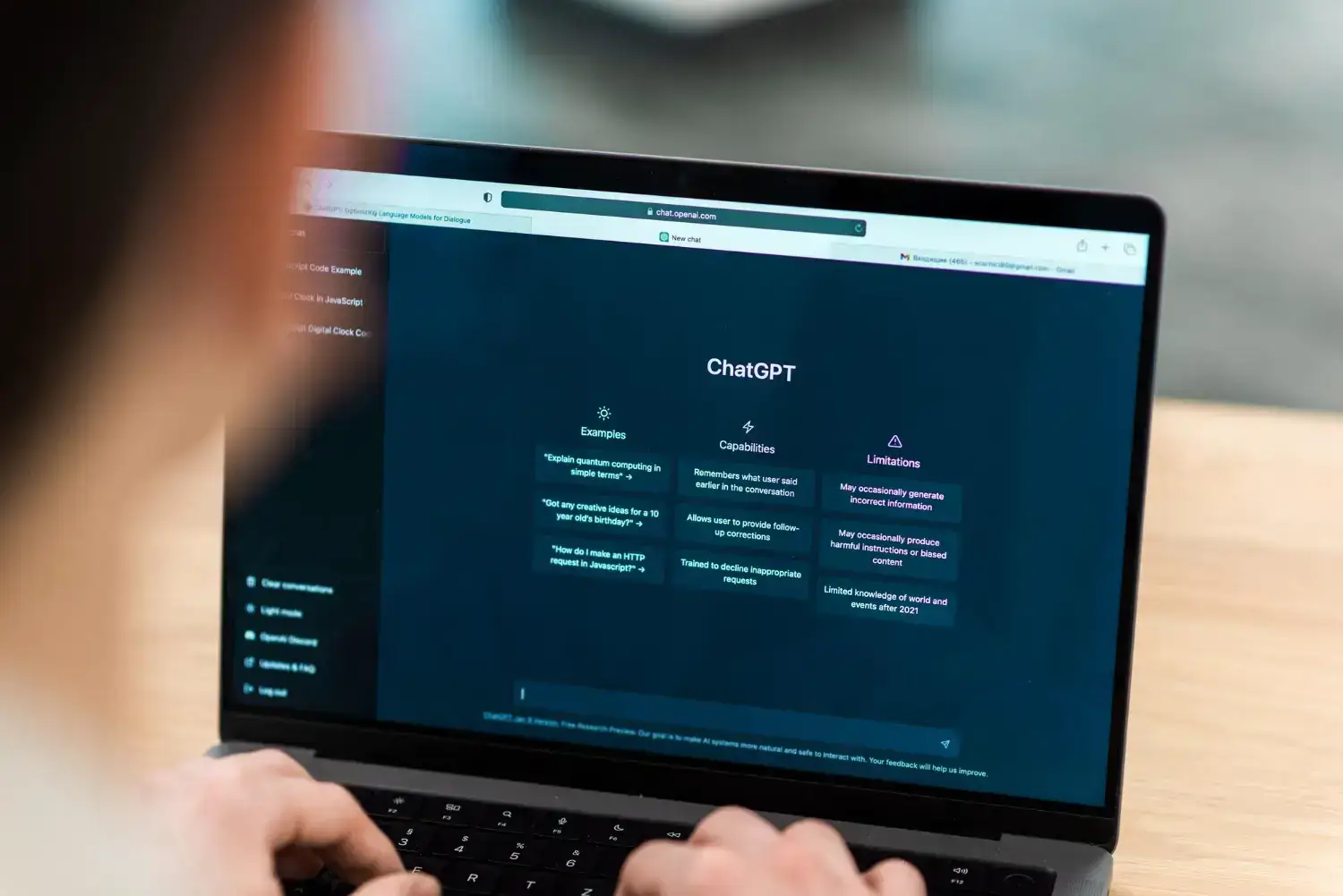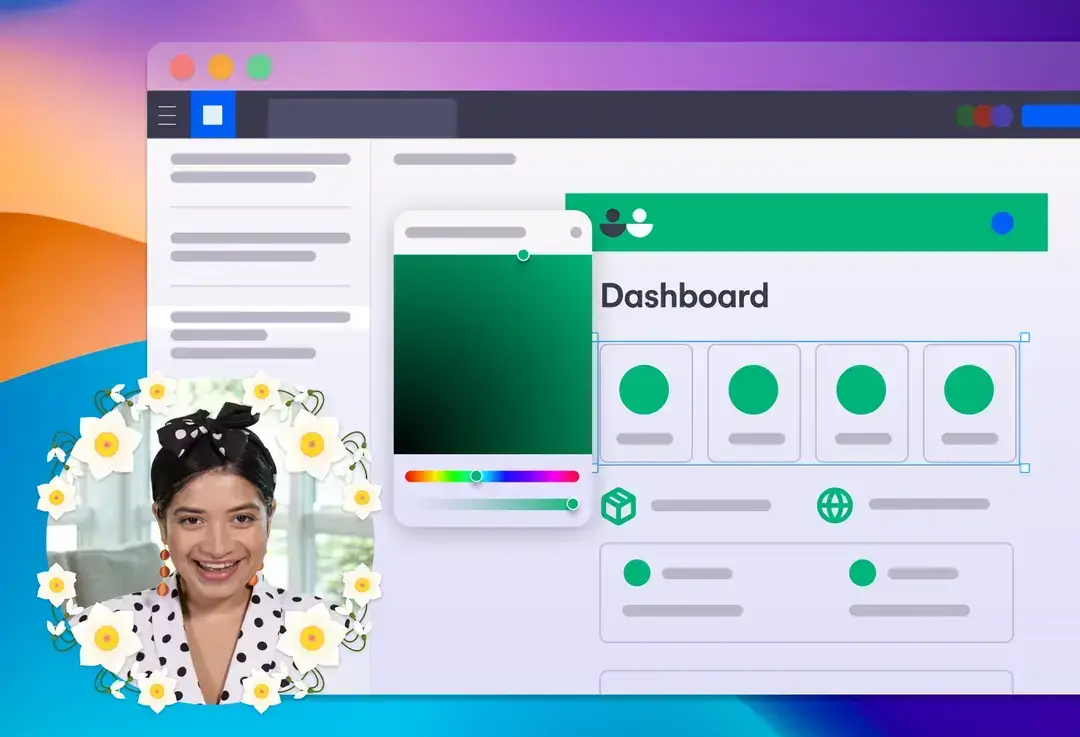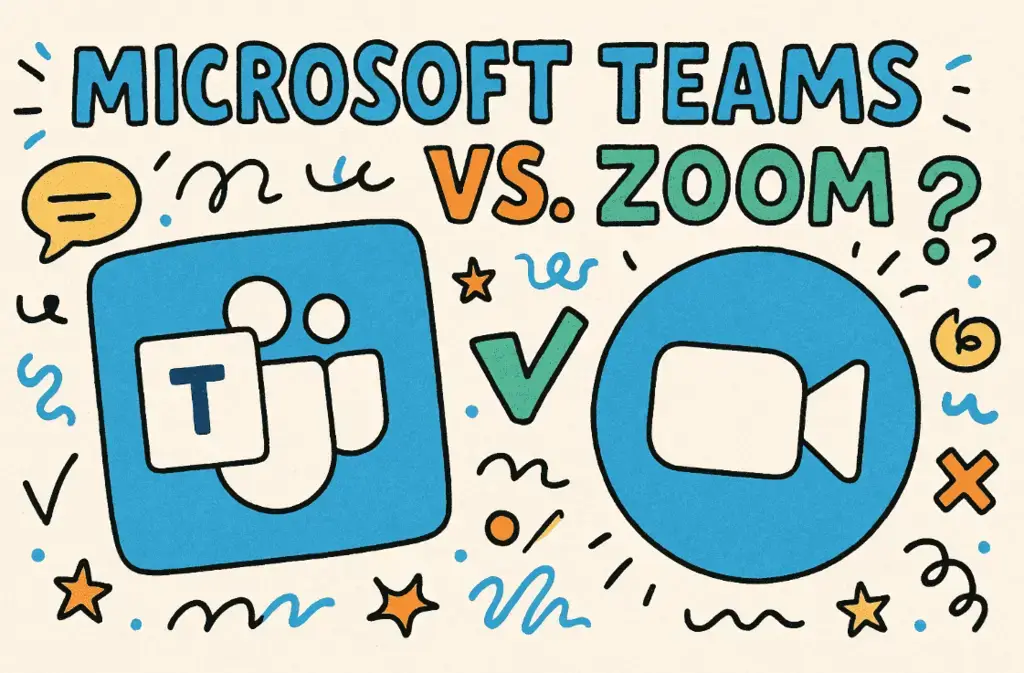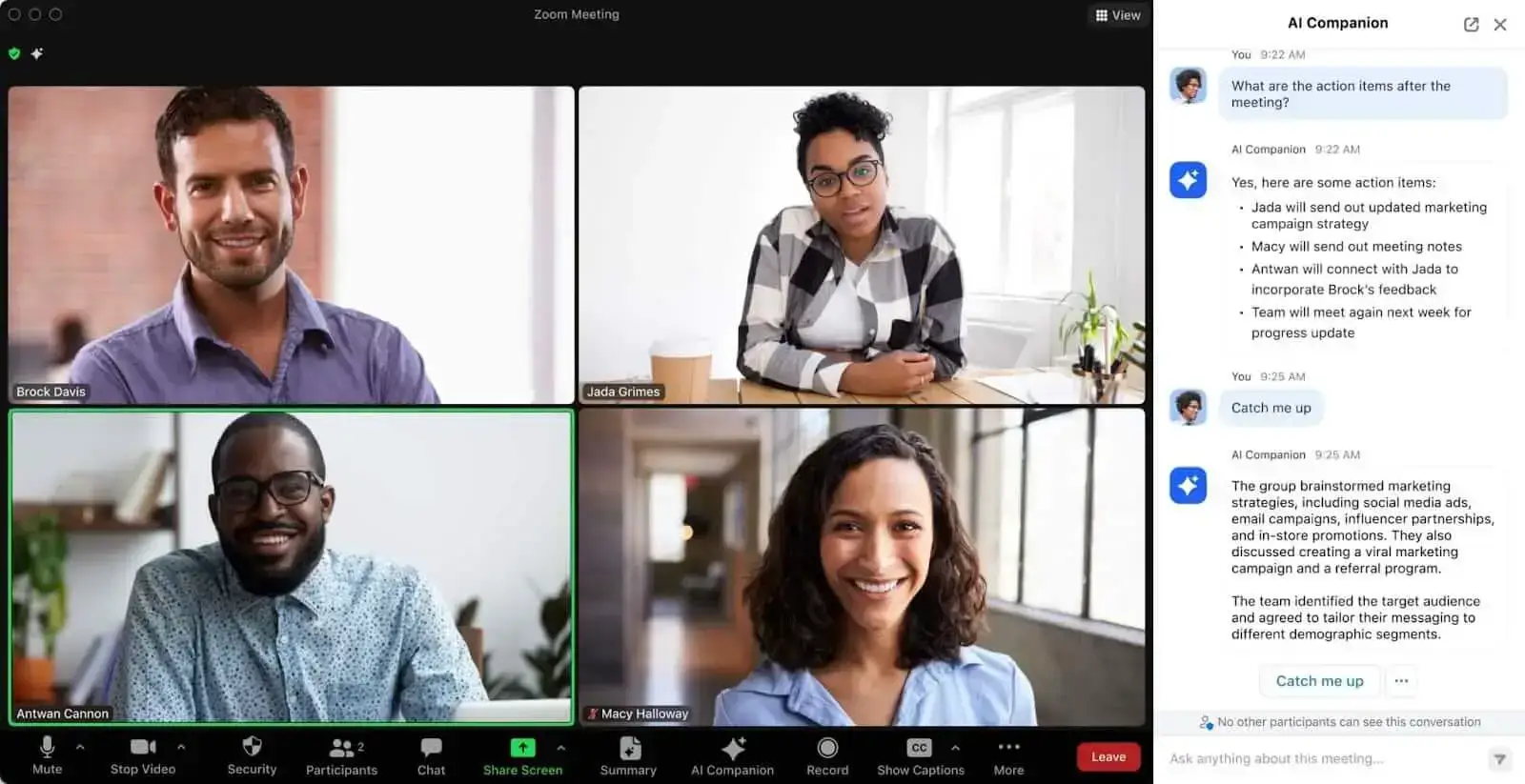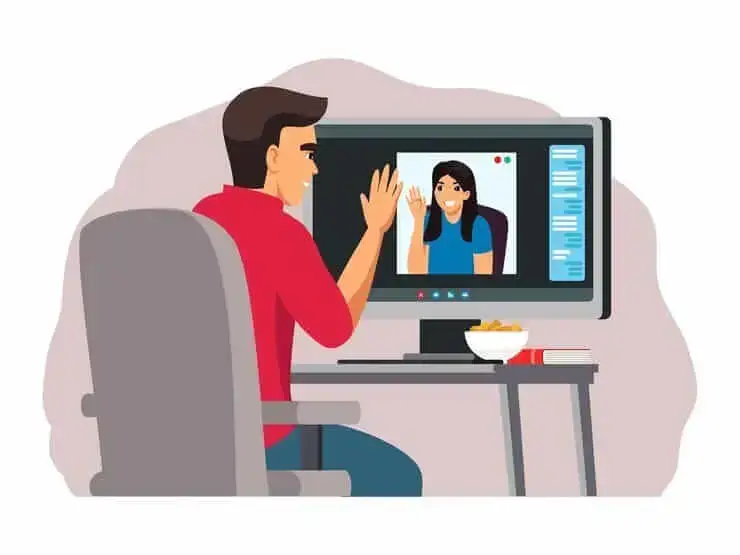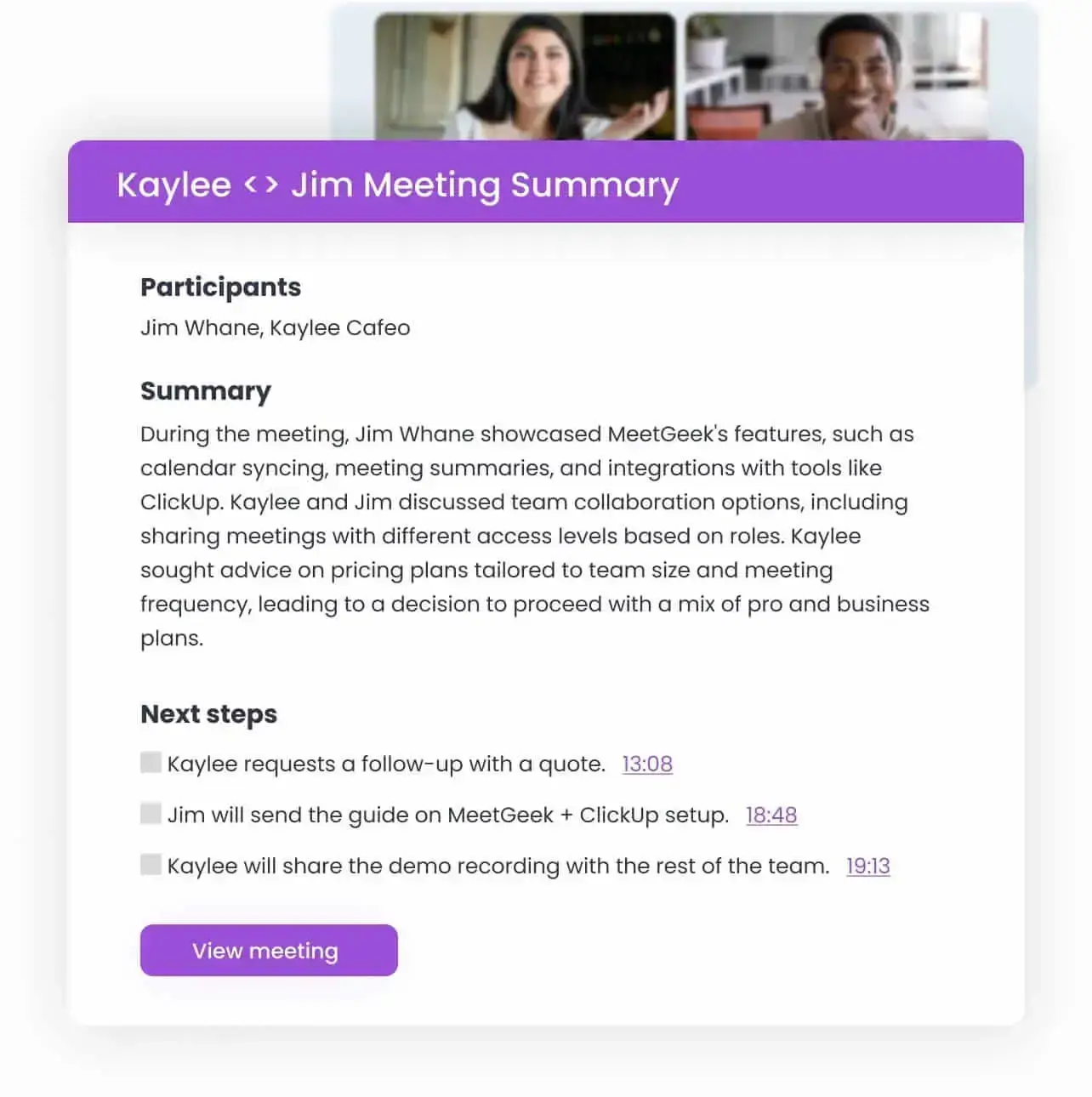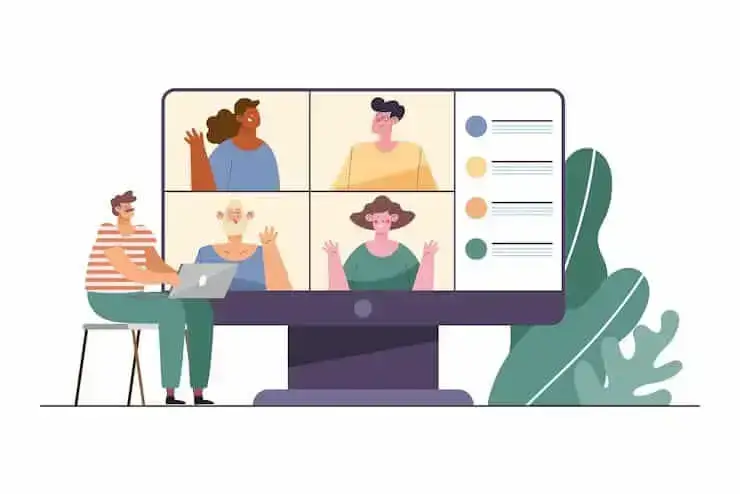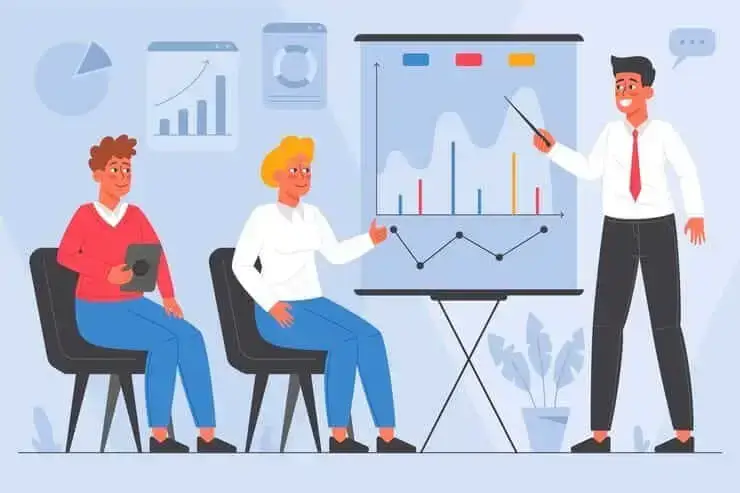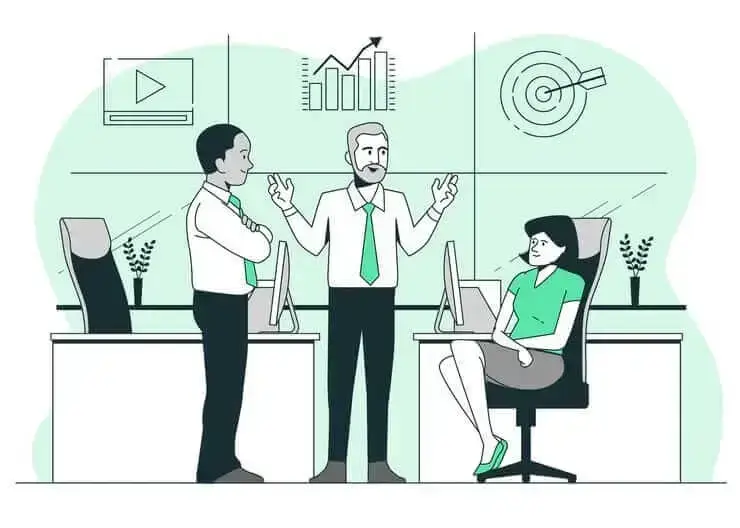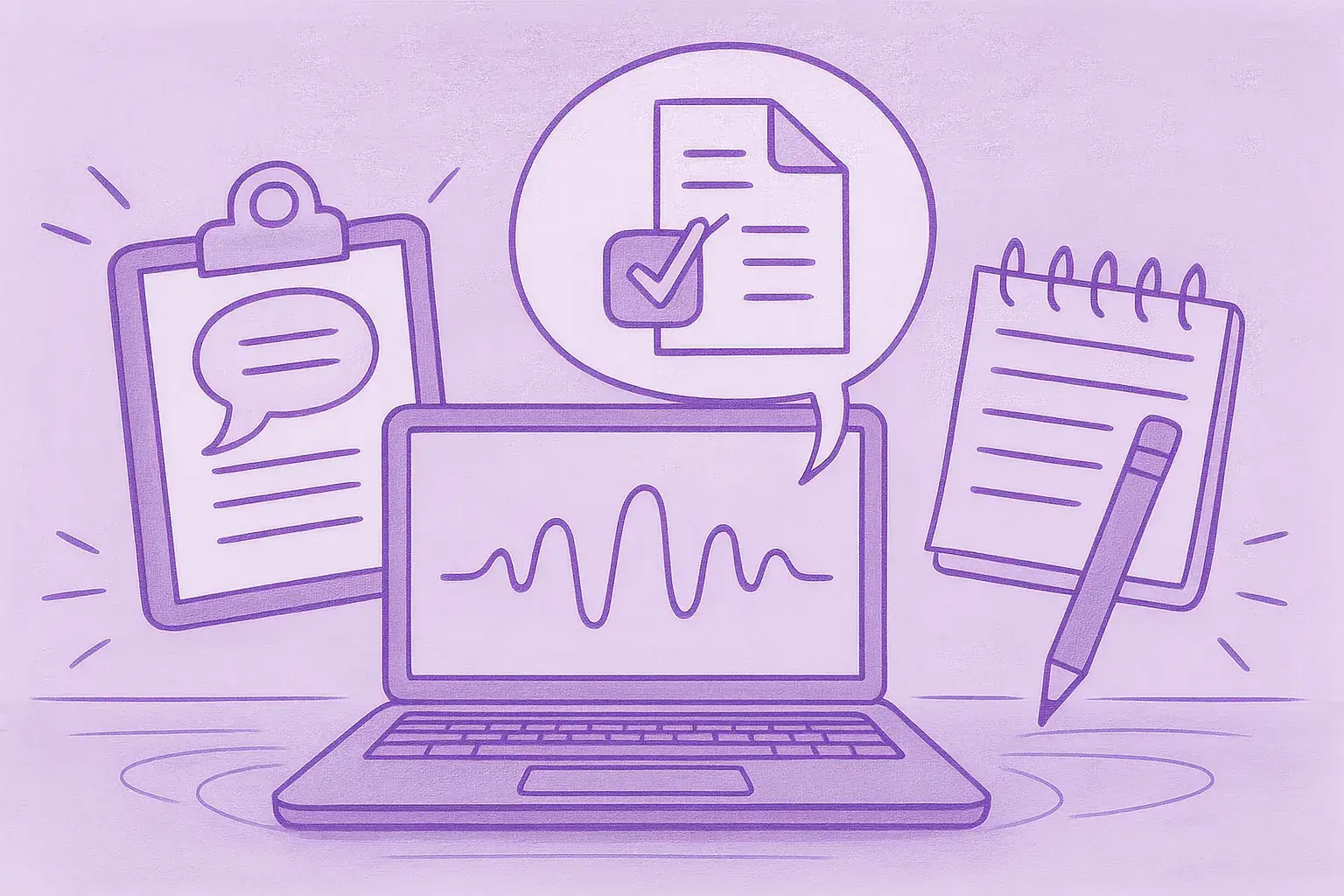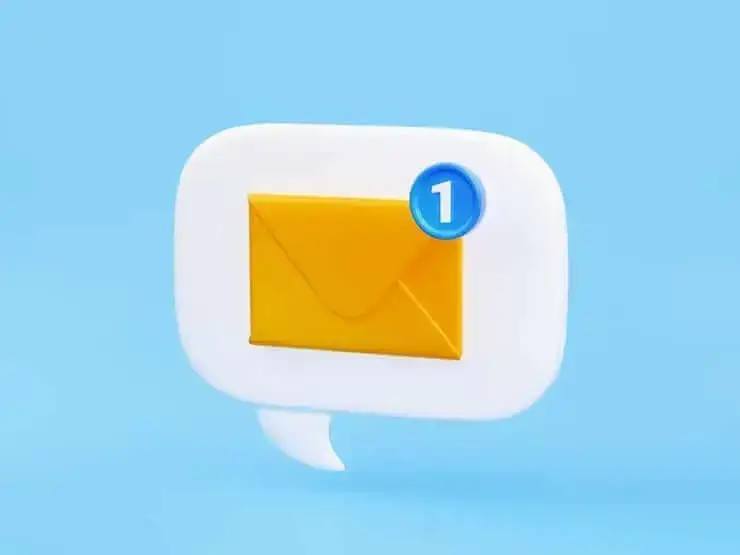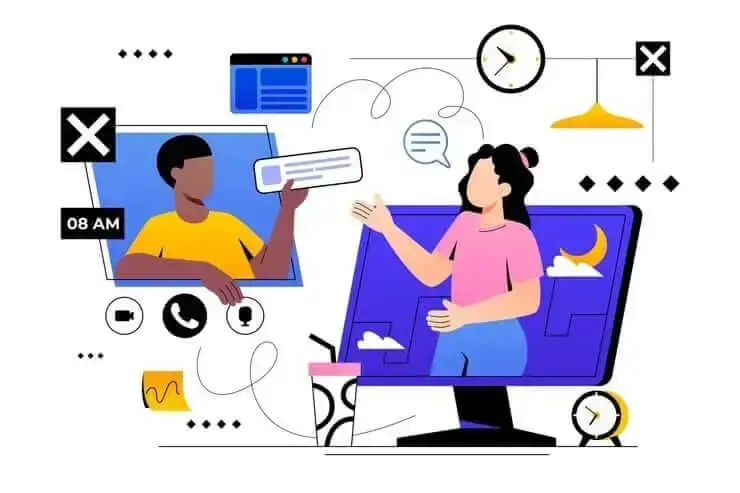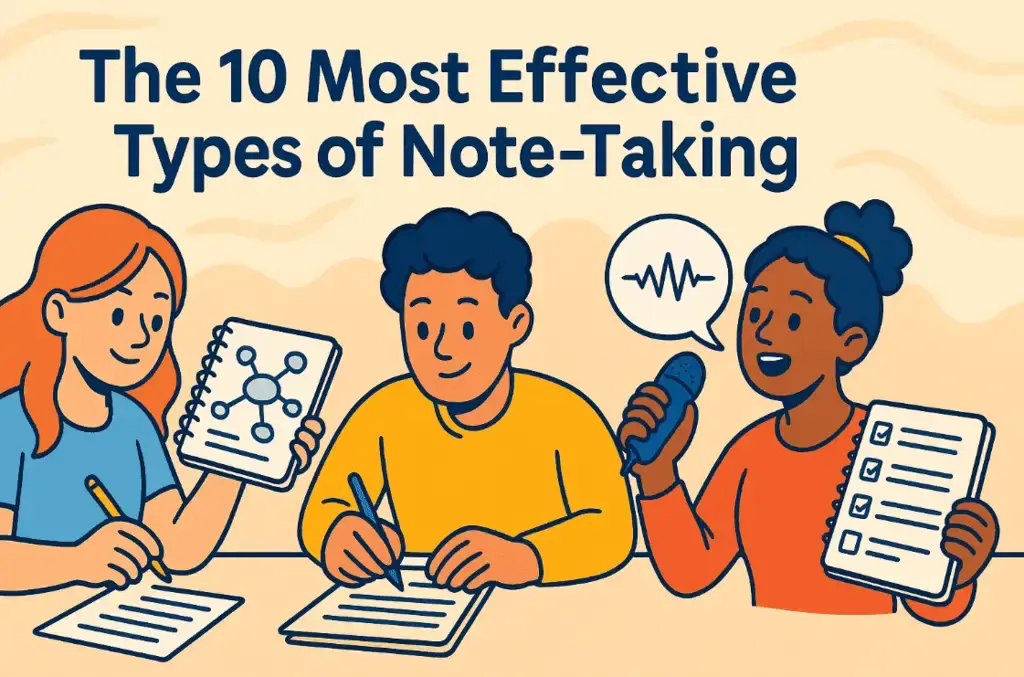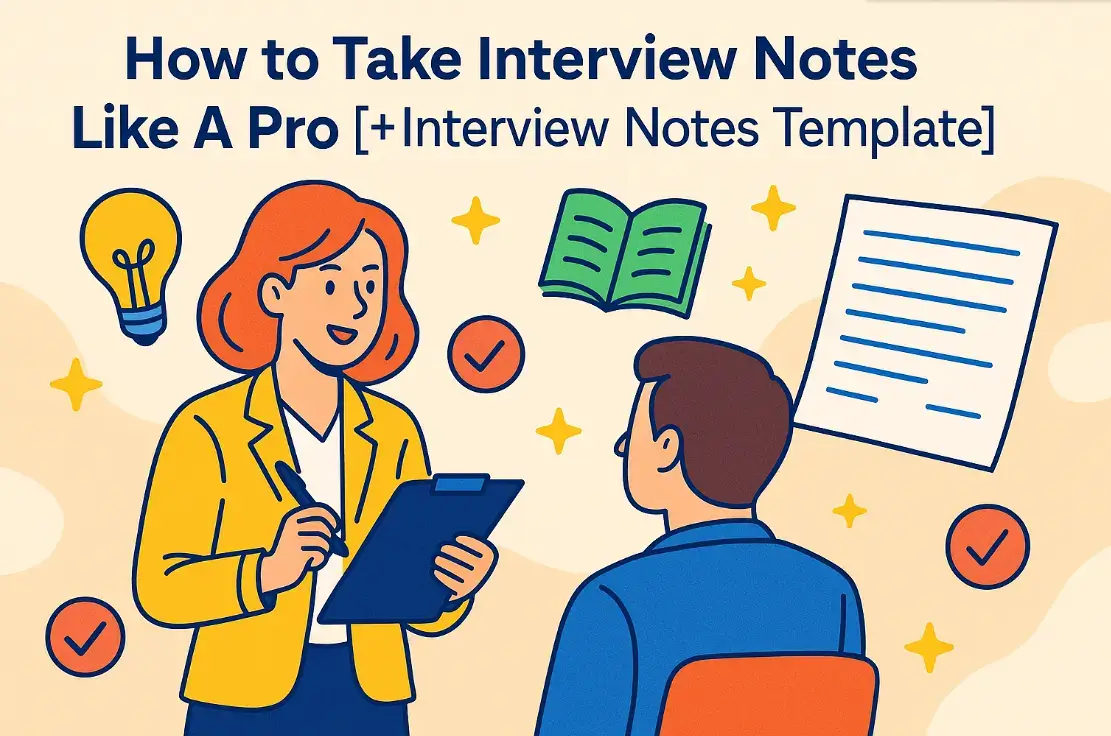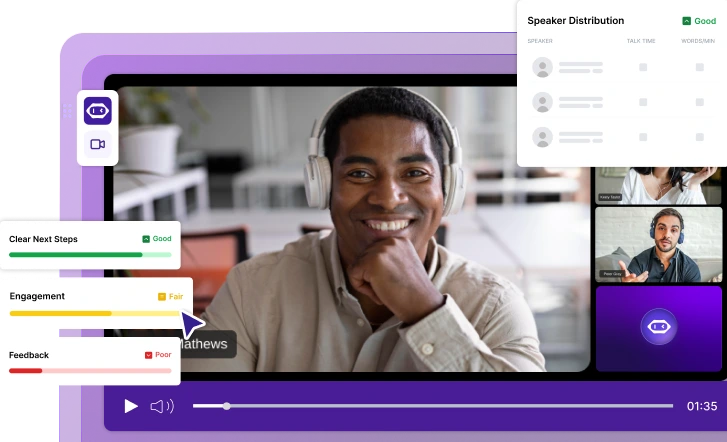How to Take Minutes for a Meeting Like a Pro [+ Free Customizable Template]
Take flawless meeting minutes every time! Learn expert tips to capture key points, track action items, and impress your team with professional note-taking skills.

✅ Free meeting recording & transcription
💬 Automated sharing of insights to other tools.

Taking meeting minutes sounds simple, right? But it’s not always that easy. In offline meetings, it can be hard to keep up when people talk over each other or jump between topics. In online meetings, you might deal with bad audio, people forgetting to unmute, or missing key points because of connection issues.
If you’ve ever finished a meeting wondering if you caught everything important, you’re not alone. In this article, we’ll teach you how to take meeting minutes like a pro, whatever the format of your meeting. Without further ado, let’s get into it!
What Are Meeting Minutes?
Meeting minutes are notes that summarize discussions from a meeting. They include key details like the topics discussed, decisions made, and tasks assigned, along with who’s responsible for each task.
Meeting minutes help keep everyone aligned, especially if someone misses the meeting. They are also a historical record that makes it easy to track progress and look back at what meeting attendees agreed on whenever you need to.
Meeting Minutes vs. Meeting Notes
TL;DR: While people often use meeting minutes and meeting notes interchangeably, they’re not exactly the same. Meeting minutes focus on documenting formal decisions and actions while meeting notes are more flexible and for personal reference. Both are useful, depending on what you need to track after the meeting.
Here are the main differences between meeting minutes and meeting notes:
✔ Meeting minutes are an official record of what was discussed and decided, often used in business, legal, or professional settings. Meeting notes are more informal, meant for personal use or to share with your team, just to capture key points, ideas, or tasks.
✔ Minutes follow a set structure, including details like meeting date, board chair, attendees, agenda items, decisions made, and who’s responsible for specific tasks. Notes, however, are a flexible written record where you can jot down bullet points, quick summaries, or personal reminders without worrying about structure.
✔ Minutes focus on the essentials like decisions made, tasks assigned, and key outcomes, without unnecessary details. Meanwhile, notes can be as detailed or casual as you want, including interesting ideas, highlights from discussions, or things you want to remember.
✔ Meeting minutes are usually shared with all attendees (and board members) and kept for future reference, along with other documents, especially in formal settings like board meetings. Meeting notes are more personal: you might keep them for yourself or share them with a small team, especially after informal check-ins or brainstorming sessions.
Who Should Write the Meeting Minutes?
The person who writes the meeting minutes is usually a team member, project manager, or admin, depending on the meeting. For formal meetings, like board meetings, it’s often the secretary.
If the meeting covers complicated topics, it helps if the note-taker understands the subject so they know what’s important to write down.
NOTE: In more casual settings, meeting participants may rotate recording meeting minutes, so it doesn’t get too repetitive for one person. The best people for the job are those who are organized, listen well, and can quickly pick out the important stuff without getting lost in the details.
How to Create Meeting Minutes for Online Meetings
Taking meeting minutes during online meetings can be harsh. You’re trying to listen, take notes, and keep up with fast conversations, all while dealing with tech glitches or people talking over each other.
That’s why automation is a game-changer. Instead of typing notes, you can use tools that automatically transcribe and summarize everything for you. No stress, no missed points.
Here are the best tools (free & paid) to help you create meeting minutes for online meetings:
1. MeetGeek
2. Google Meet’s AI note-taker
3. Zoom’s AI companion
4. MS Teams
1. MeetGeek
If you’re tired of juggling note-taking during meetings, MeetGeek is a game-changer. It’s an AI-powered meeting automation and collaboration tool that takes the hassle out of writing meeting minutes.
Unlike Zoom, Microsoft Teams, or Google Meet, you don’t need to be the host or even have a paid plan to use MeetGeek. It works seamlessly with all three platforms, and you can get started for free with the option to upgrade if you need more features. Additionally, it works on both desktop and mobile, so you’re covered even on the go.
MeetGeek automatically joins your meetings, records them, and generates detailed transcriptions in 60+ languages. Its AI algorithms identify important moments, highlight key points, and pull out action items so you know exactly what to focus on after the meeting. You’ll also get AI meeting notes that are clear, concise, and easy to share with your team.What’s even better is how MeetGeek integrates with tools like Slack, Notion, and 7,000+ other apps, so you can effortlessly move meeting notes into your existing workflows.
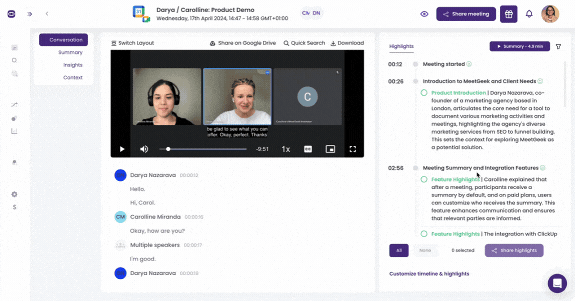
Key Features of Using MeetGeek for Meeting Minutes:
- MeetGeek joins Zoom, Google Meet, and Microsoft Teams meetings even when you can’t attend yourself.
- MeetGeek provides concise, easy-to-read summaries right after the meeting, highlighting key tasks so you can focus on what matters most.
- When you need to find something specific, you can use the searchable transcripts feature to jump right to the part of the meeting you need.
- MeetGeek sends summaries and action items straight to your team’s inboxes.
- You can catch up on meetings anytime, anywhere with the MeetGeek mobile app.
- We keep all your previous meeting minutes and recordings in one secure, searchable place.
2. Google Meet AI Note-Taker
Taking meeting minutes in Google Meet has gotten a lot easier thanks to the “Take Notes for Me” feature. This AI feature automatically creates a summary of key points, assigns action items to specific attendees, and even shares the notes after the meeting. The notes are saved in a Google Doc, which gets attached to the calendar event for easy access.
Also, since Google Meet is part of Google Workspace, it integrates smoothly with tools like Google Calendar, Drive, and Gmail, making it convenient if your team already relies on Google’s services.
However, there are some limitations to keep in mind. The AI note-taking feature is only available on specific Google Workspace plans like Gemini Enterprise, Gemini Education Premium, or with the AI Meetings & Messaging add-on, which all come at an extra cost. Plus, it only works in English and can only be used on a computer or laptop.

Key Features of Using Google Meet for Meeting Minutes:
- Automatically summarizes key points and assigns action items
- Sends notes to attendees and the organizer via email
- Helps latecomers catch up without disrupting the meeting
- Works seamlessly with Calendar, Drive, and Gmail
3. Zoom’s AI Companion
Recording meeting minutes on Zoom is super easy thanks to its AI Companion. It can automatically take notes, track key points, and list out action items. It can also create a summary of the meeting once it’s over, so you don’t have to worry about missing anything.
But there are a few downsides. If you’re not the meeting host, you won’t be able to access the meeting summary or recordings unless the host shares them with you. Also, if you’re using the free version of Zoom, some advanced features like smart recordings, meeting summaries, and integrations with certain tools won’t be available, meaning you might still need to take some notes manually.
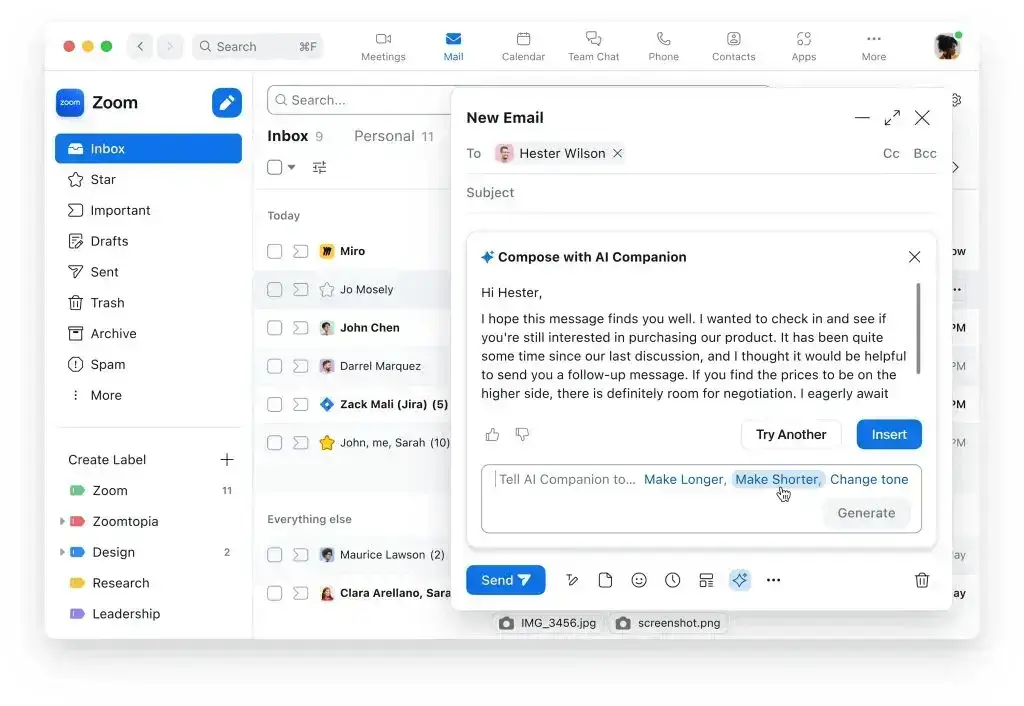
Key Features of Using Zoom for Meeting Minutes:
- Sends a recap to the host after the meeting
- Highlights key parts of the meeting and organizes them into chapters
- Lists follow-up tasks right under the meeting recording
- Works with 2,798 tools including Asana, Slack, Trello, and MeetGeek to manage tasks easily.
4. MS Teams
Taking meeting minutes in Microsoft Teams is pretty straightforward, especially with its built-in features that help you save time and stay organized. The Intelligent Recap feature automatically captures meeting notes, highlights key points, and even suggests actionable steps, so you don’t have to worry about transcribing every single detail.
Microsoft Teams also integrates seamlessly with other Microsoft tools like Word, Excel, PowerPoint, SharePoint, and OneDrive, which makes managing meeting notes easy if you’re already using these apps.
However, if you’re using the free version of Teams, some advanced features like AI-generated translations and detailed meeting analytics aren’t available, which means you’ll need to rely more on manual note-taking.
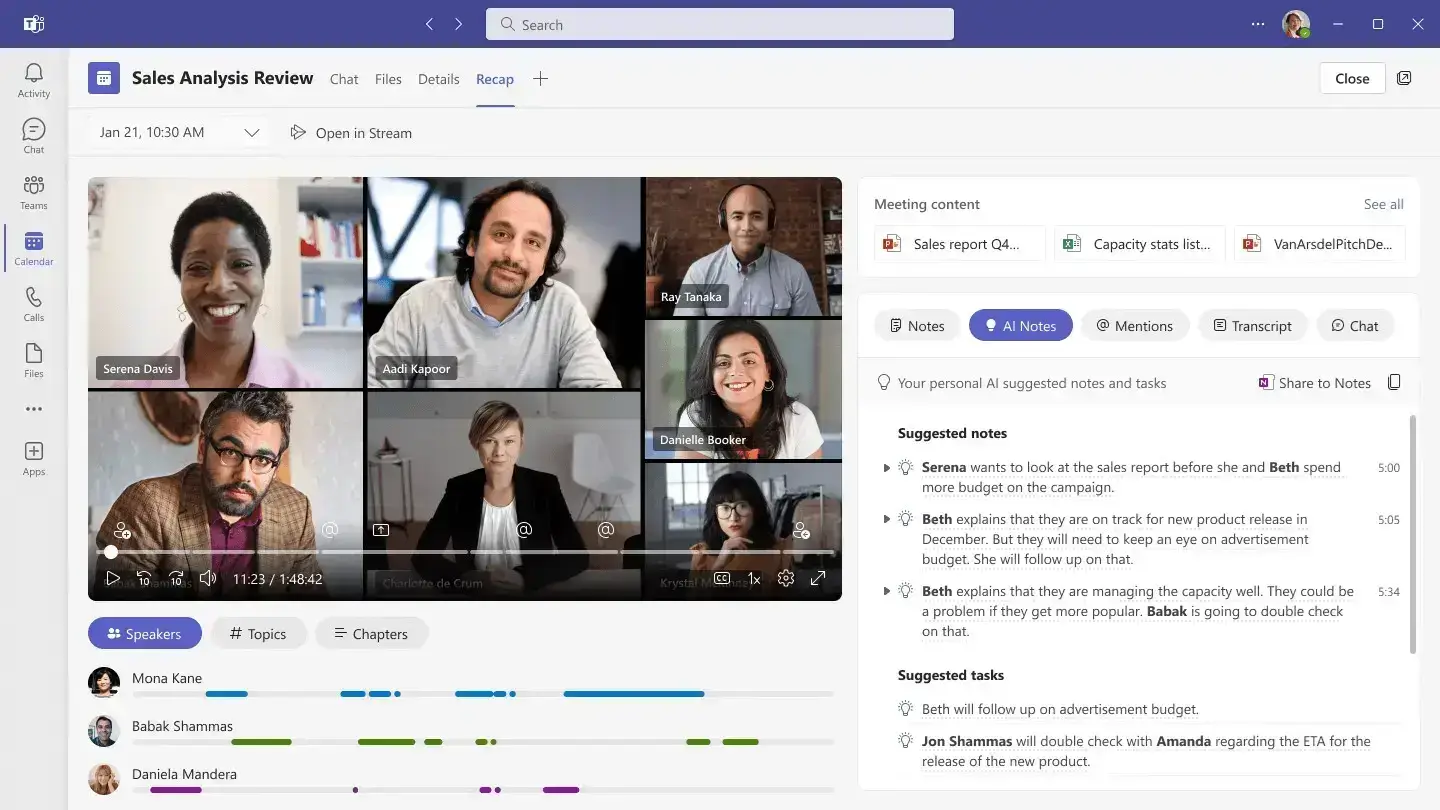
Key Features of Using Microsoft Teams for Meeting Minutes:
- Transcribes meetings in real-time, with transcripts available after the meeting
- Knows when participants join or leave, so they can review missed parts easily
- Supports tools like MeetGeek, Google Drive, ClickUp, and GitHub
- Available for premium users, translating meetings into 40 languages
How to Create Meeting Minutes for Offline Meetings
Back in the day, taking meeting minutes was self-explanatory (think pen, paper, and maybe a printed agenda for reference). Someone would sit with a notepad, trying to keep up with everything said, scribbling down key points, decisions, and action items.
While this worked, it often meant missing important details and spending extra time compiling notes to share with the team. Nowadays, this approach can feel outdated, especially when we have tools that can automate, organize, and streamline the process.
MeetGeek’s mobile app makes minute-taking super easy. Whether you’re in a conference room, at your desk, or attending an event, MeetGeek can record conversations and automatically turn them into an accurate reference point for the entire team to reflect on. All you need to do is open the mobile app and hit record. MeetGeek will handle the rest, capturing in-person meetings, interviews, coaching sessions, or conference talks.
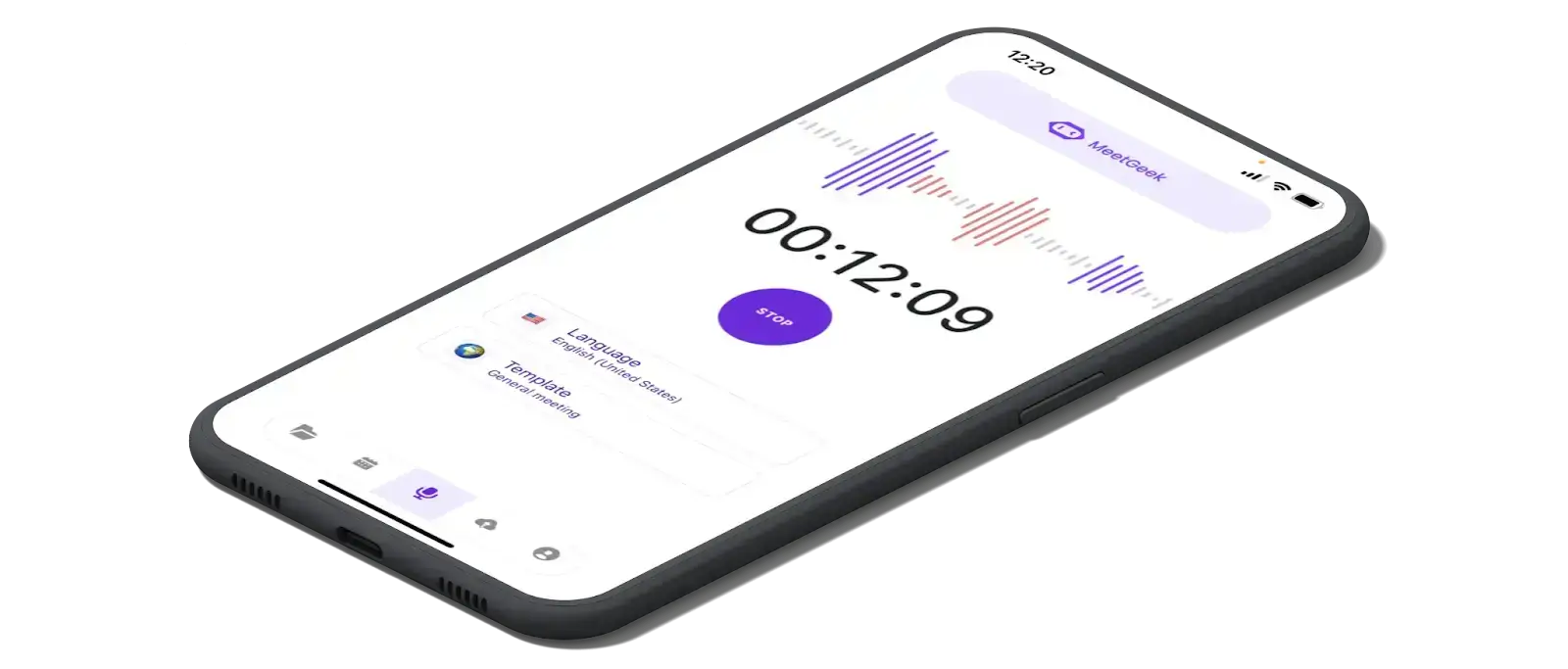
After the meeting, you can review the notes, listen to the recording, or check out the AI-generated summaries right from your phone. This is great for when you’re on the go and need to catch up before your next meeting.
Plus, the app makes it easy to search for specific points in your notes and share them with your team if needed.
Best practices for creating meeting minutes for offline meetings
- Before the session, check the meeting agenda so you know what topics will be covered and what to focus on. Have a list of attendees ready so you don’t waste time writing names during the meeting.
- Get your note-taking tools ready, whether that’s a notebook, laptop, or tablet. If you’re using a pen, bring an extra just in case.
- During the session, don’t stress about writing down meeting details. Focus on the important stuff like the date and time, who’s there (and who’s not, if that matters), and key points from the agenda.
- Write down any decisions made, tasks assigned, deadlines set, formal motions, and important discussions. Note who’s responsible for each task and any deadlines. Using bullet points can help keep things clear and organized.
- For effective minute taking, use shortcuts like abbreviations or symbols (for example, “@” for tasks or “→” for next steps). Highlight key points with underlines or stars if you’re writing by hand, or bold text if you’re typing. Leave some space between notes so you can add more details later if needed.
- After the meeting, go over your notes while everything is still fresh. Rearrange them if needed to match the meeting’s flow, clear up anything that’s messy, and double-check that all action items are correct with the right people and tasks.
- Use short paragraphs or bullet points, and make important tasks stand out with bold text. Stick to the facts, as there’s no need to add personal opinions or extra details.
- Finally, share the meeting minutes and other relevant documents with everyone who attended (and anyone else who needs to see them, like guest speakers). Have your minutes approved, and save the document somewhere easy to access, like a shared folder.
BONUS: Free Meeting Minutes Template
1. Meeting Details
- Meeting Title: [Insert meeting name]
- Date: [Insert date]
- Time: [Insert start time] – [Insert end time]
- Location/Platform: [Insert meeting room, Zoom, Microsoft Teams, Google Meet, etc.]
- Facilitator/Chair: [Insert name]
- Note-Taker: [Insert name]
2. Attendees
- Present: [List all attendees]
- Absent: [List anyone who couldn’t attend, if relevant]
3. Agenda Overview
| Agenda Item | Presenter | Time Allocated |
|---|---|---|
| [Insert topic 1] | [Insert name] | [Insert time] |
| [Insert topic 2] | [Insert name] | [Insert time] |
| [Insert topic 3] | [Insert name] | [Insert time] |
4. Key Discussion Points
- [Topic 1]:
- [Summarize key points discussed]
- [Add relevant notes, ideas, or feedback]
- [Topic 2]:
- [Summarize key points discussed]
- [Add relevant notes, ideas, or feedback]
- [Topic 3]:
- [Summarize key points discussed]
- [Add relevant notes, ideas, or feedback]
5. Decisions Made
- [Decision 1: Clearly state the decision made]
- [Decision 2: Include any agreements, approvals, or conclusions]
- [Decision 3: Note any important changes or updates]
6. Action Items
| Action Item | Assigned To | Deadline | Status |
|---|---|---|---|
| [Insert task 1] | [Insert name] | [Insert due date] | [Not Started/In Progress/Complete] |
| [Insert task 2] | [Insert name] | [Insert due date] | [Not Started/In Progress/Complete] |
| [Insert task 3] | [Insert name] | [Insert due date] | [Not Started/In Progress/Complete] |
7. Parking Lot (Optional)
(For topics that came up but weren’t discussed in detail. Save them for future meetings.)
- [Insert topic 1]
- [Insert topic 2]
8. Next Steps
- [Summarize what’s next: upcoming deadlines, follow-up meetings, tasks to complete]
9. Additional Notes (Optional)
- [Add any extra details, observations, or notes that don’t fit elsewhere]
Meeting Approval (Optional)
- Reviewed and Approved by: [Insert name(s)]
- Date: [Insert date]
💡PRO TIP: How to Customize This Template
- Add this template to MeetGeek and get follow-ups that follow this exact structure
- Add or remove sections based on your team’s needs
- Use bullet points or tables, whatever keeps things clear
- Highlight action items and decisions to make them stand out
- Add your company’s logo or branding if needed
Take Minutes for Your Next Meeting with MeetGeek!
Taking meeting minutes doesn’t have to be stressful. With the right approach, you can capture all the important details without feeling overwhelmed.
But why do all the heavy lifting yourself? Let MeetGeek record, transcribe, and summarize your meetings, so you can focus on the conversation while AI handles the rest. It’s quick, easy, and helps you stay on top of every detail like a pro!
.avif)





